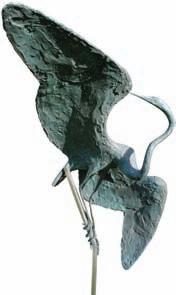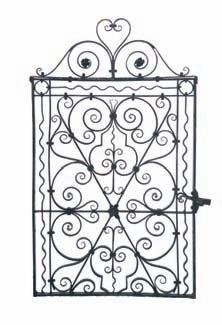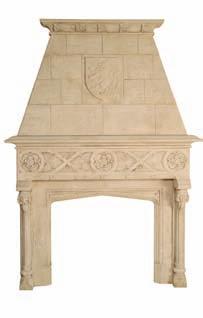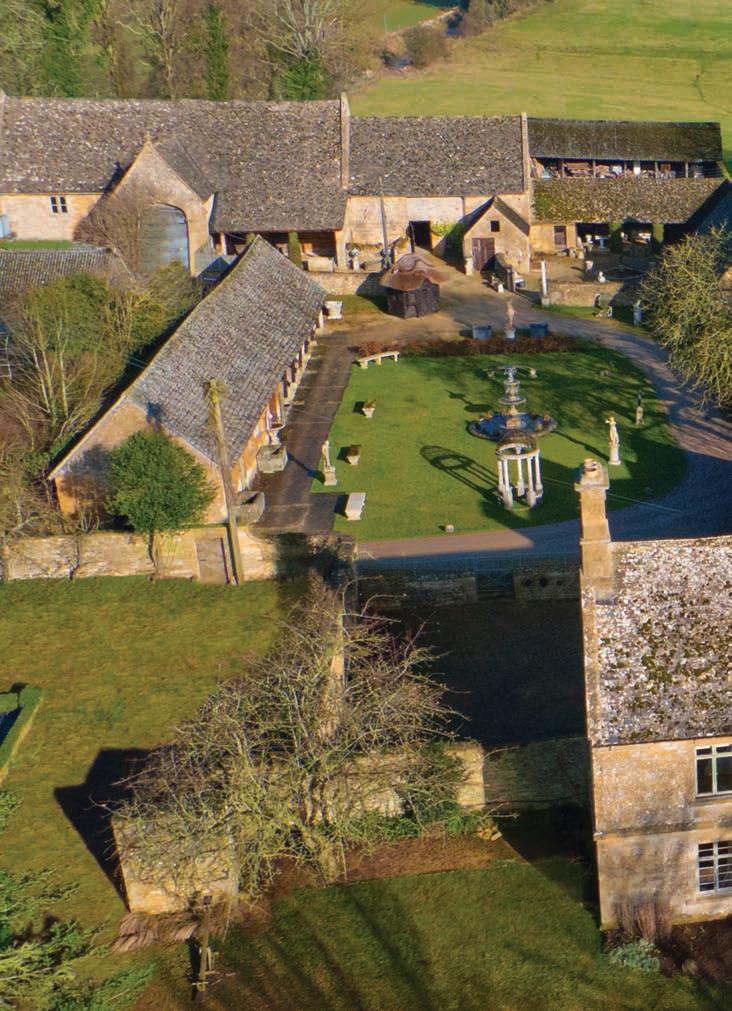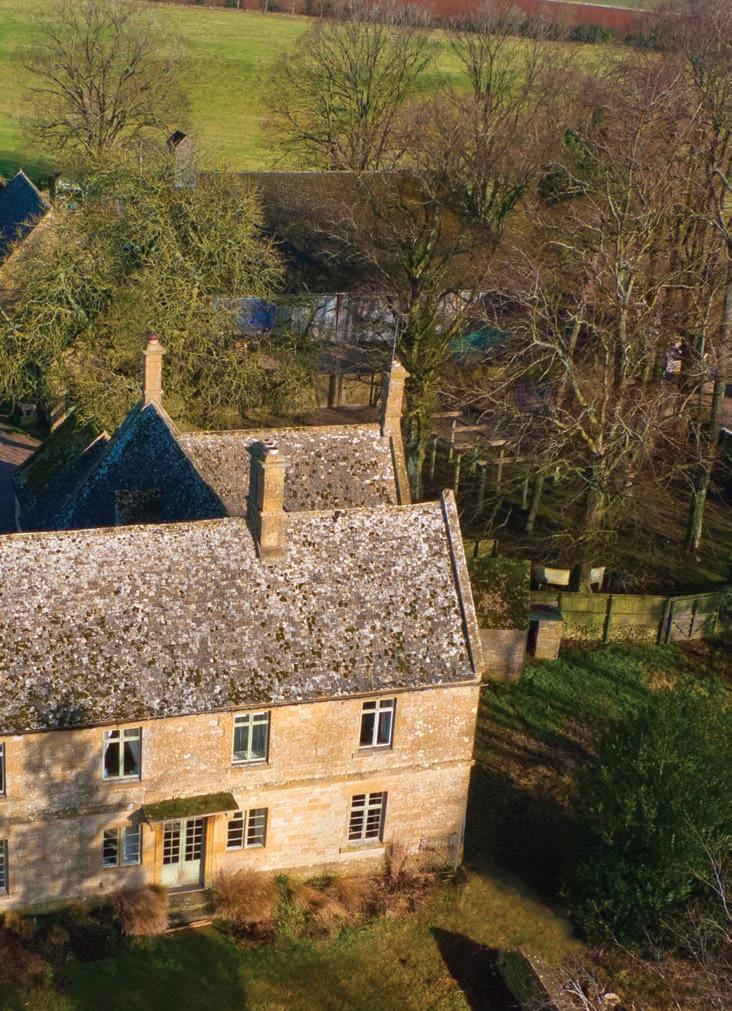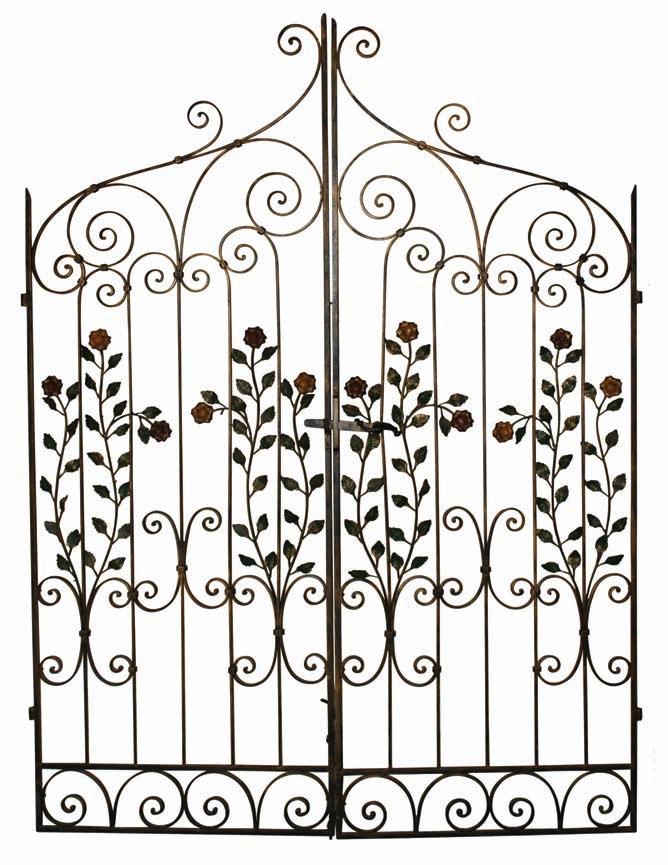PERIOD GARDEN STATUARY ARCHITECTURAL ELEMENTS & MODERN SCULPTURE

Street Sweeper
Peter Laszlo Peri (1899 – 1967)
Modelled in coloured cement (known as ‘Pericrete’), circa 1955, signed ‘Peri’. Peri himself described how, when he was making sculpture of a social type such as a street sweeper, he would ‘…show him not as a pompous heroic figure, but as part of our surroundings.
I choose one of his characteristic resting poses, I have drawn my neighbour’s attention to another neighbour whom he passed a thousand times on the street, but to whom he never gave a second thought.’ Extracted from Sculpture in 20th Century Britian - A guide to sculptors in the Leeds collections. Peri exhibited widely and his works are held in the Tate, The British Museum and the Leeds City Art Gallery among others.
Height 2 ´ 8˝ [81 5 cm] Width at base 11 ˝ [28 cm]
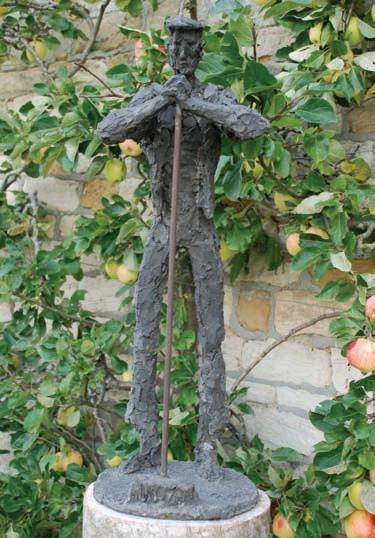
[ ]
Joy of Life
Thomas Bayliss Huxley-Jones (1908 – 1969)
Sculpted in bronzed resin this work relates to the famous Joy of Life fountain in Hyde Park, sculpted by Huxley-Jones in 1963
Other works include the fountain and gilded figure of Helios at the BBC TV Centre in London, David Livingstone at the Royal Geographical Society and the bronze Sea Fantasy in Aberdeen. He was elected a Fellow of the Royal Society of British Sculptors in 1955 and received numerous awards for his work. Height
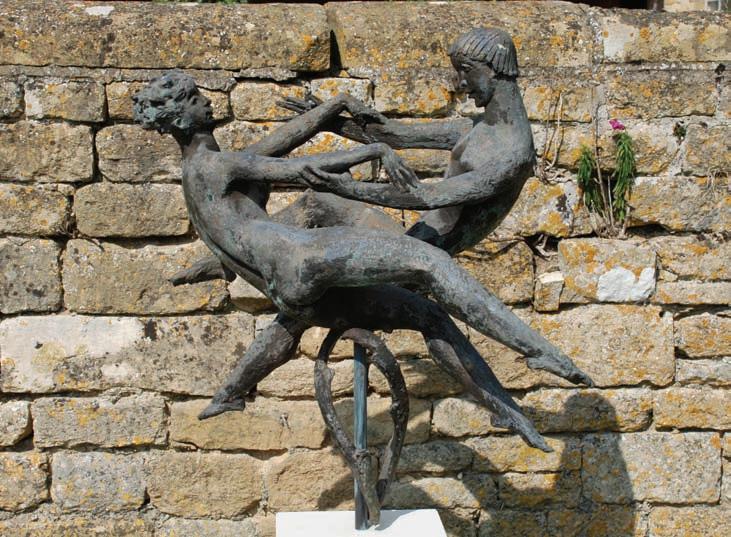
[ 5 ]
2 ´ 10 ˝ [86 cm] Width 2 ´ 10 ˝ [86 cm]
2 ´ [61 cm]
Depth
Preening Bird
David Wynne (1926 – )
Cast in bronze with an aluminium stem, monogrammed and dated 1966, numbered 2/6. This sculpture relates to a series of bird sculptures by David Wynne exhibited at Arthur Tooth & Sons, Bruton Street, London W1, in March 1966 Preening Bird is listed and illustrated in the original catalogue and interestingly priced at £20. Height 2 ´ 10½˝ [88 cm] Square at base 12 ˝ [30 cm]
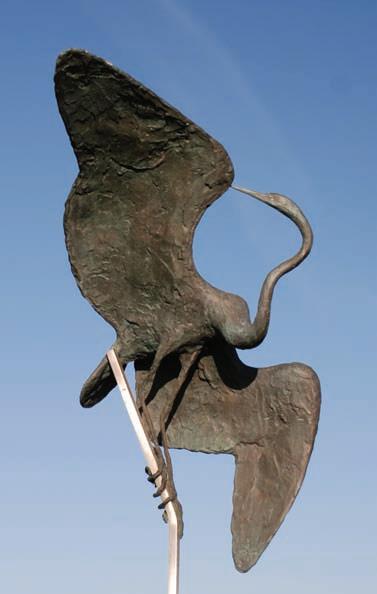
[ 6 ]
Untitled
Jon Isherwood (1960 – )
This work was completed in 198, the year Jon Isherwood became Anthony Caro’s assistant. The steel was originally from Caro’s studio and the piece was exhibited at the Great Lingford Art Centre, where it was purchased by the architect John Taylor and removed to Castell Gyrn, Ruthin, Wales. Jon Isherwood was a protégé of Anthony Caro, working between 198 – 1986 as a sculptural technician and from 1988 – 1993 as a participating artist at Caro’s Triangle Artists Workshop in Pine Plains, New York. Jon Isherwood now lives and works in America and I wish to thank him for his assistance in cataloguing this work.
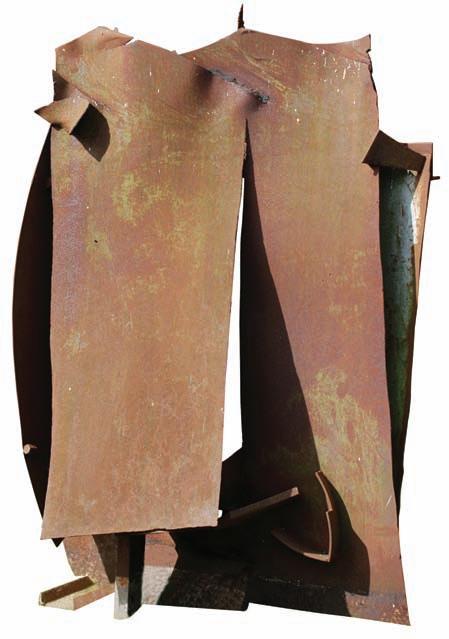
[ 7 ]
Height 7 ´ [213 cm] Width ´ 5 ˝ [135 cm] Depth 1 ´ 7 ˝ [8 cm]
Untitled


Richard Perry Bedford (1883 – 1967)
Devon marbles, Berryhead and Ashburton, circa 1958. Similar to Bedford’s John Dory, circa 1958, shown in the 1968 retrospective exhibition The World of Richard Bedford, held at The Minories, Colchester; both works conform to his known semi-abstract oeuvre based on plant, animal and insect forms.
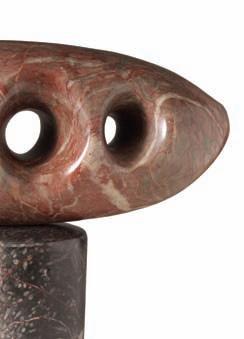
Overall height 10 ˝ [25. cm] Overall width 1' ¾˝ [2.5 cm] Depth 5˝ [12.7 cm]
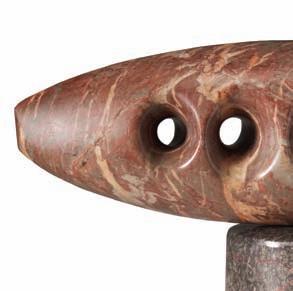
[ 8 ]
Holding It Together
Peter Randall-Page (195 – )
Carved in Kilkenny limestone in 1987, this work was exhibited at ‘Art Market’ in 1988 and ‘The Cutting Edge’ in 1989 Catalogue Raisonné
Sculpture and Drawings 1977–1992, number 87, illustrated.
Peter Randall-Page is considered one of the foremost sculptors working in Britain today, with works held in many well-known public and private collections. I wish to thank Peter for his assistance in cataloguing this work.
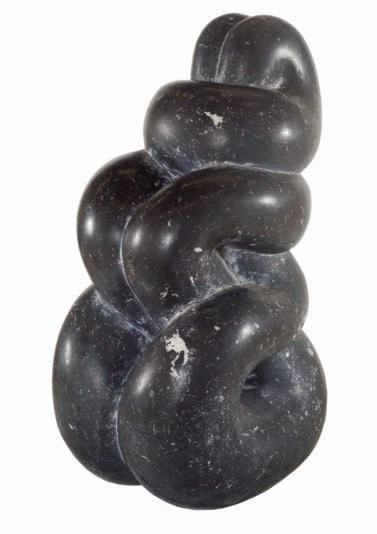
Height 1 ´ 3½˝ [39 5 cm] Width 6¾˝ [17 cm] Depth 7 ˝ [18 cm]
Provenance: the collection of the late Lady Winifred Tumin.
[ 9 ]
Lucien Crofts
Barry Flanagan, RA (191 – 2009)
A portrait bust of Lucien Crofts, aged two years old, cast in 2008 by AB Fine Art Foundry in an edition of 3, this being 1/3
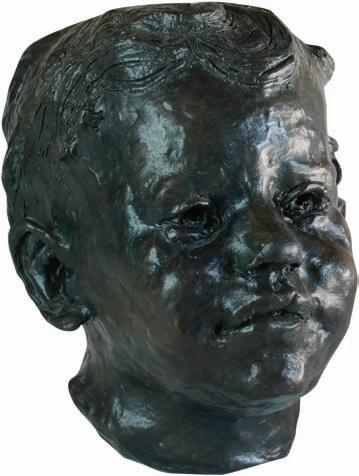
Barry Flanagan gave the original clay sculpture to Mr Tony Crofts in lieu of rent in 1963.
Height 6¾˝ [17 cm] Width ¾˝ [12 cm]
Depth 6¾˝ [17 cm]
Provenance: the deceased estate of Mr Tony Crofts.
[ 10 ]
Ivan Maisky
Jacob Epstein (1880 – 1959)
Gilt bronze
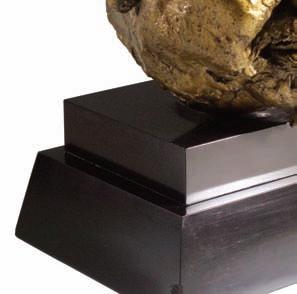

Ivan Maisky was one of the central figures in the diplomatic history of Europe in the 1930s as the Soviet Ambassador to London from 1932 – 3. Jacob Epstein produced in 1936 ‘a lively portrait bust’ of the ‘genial but shrewd’ Ambassador.
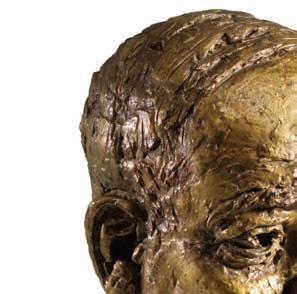
Height 10¼˝ [26 cm] Overall height 5⁵/₈˝ [36.5 cm]
Height of base ¹/₈˝ [10.5 cm]
Width of base 8½˝ [21.5 cm]
Depth of base 7½˝ [19 cm]
Provenance: the estate of Doctor and Mrs Phyllis White-Phillips.
[ 11 ]
Warrior
Elisabeth Frink (1930 – 1993)
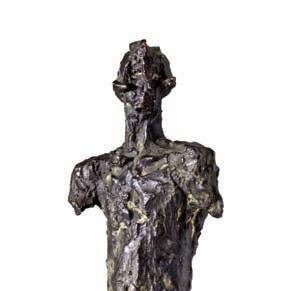
One of Frink’s earliest known works, Warrior, circa 1958; this previously unknown bronze is to be included in the new Frink Catalogue Raisonné, fitting into a series of Warriors from this time.
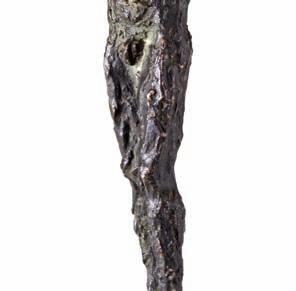
Height 1' 11˝ [22 cm] Width at base 2¾˝ [7 cm]
Depth at Base 5 ˝ [12.7 cm]
Provenance: collection of Mrs H Seligman.
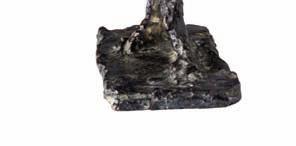
[ 12 ]


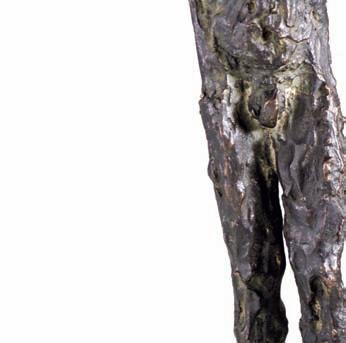

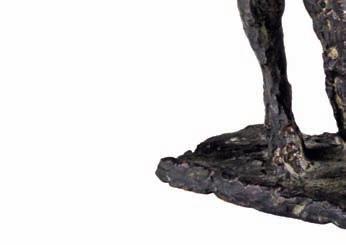
Peter
Reca McGibbon (d. 2007)
A carved wooden head of the apostle, Peter. A local artist, McGibbon was best known for her portrait bust of her good friend Stanley Spencer, now in the Cookham Museum.
Height 11½˝ [29 cm] Width 5½˝ [1 cm] Depth 5½˝ [1 cm]
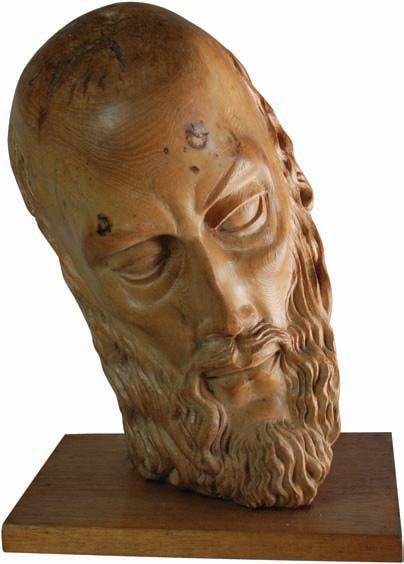
[ 1 ]
Untitled
Willi Soukop, RA (1907 – 1995)
A female portrait bust signed in the cast, ‘W Soukop’. Bronzed resin, circa 1960s.
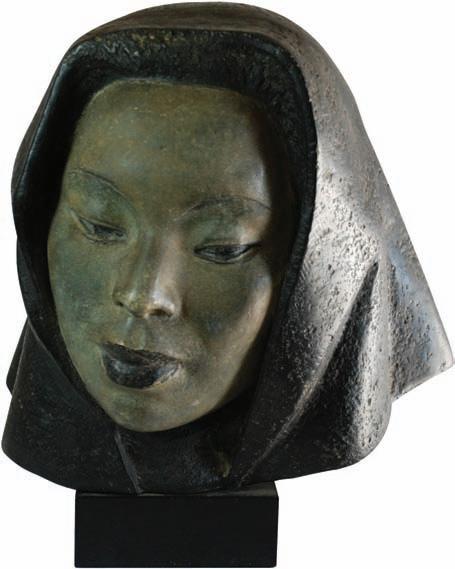
Height 11½˝ [29 cm] Width 11½˝ [29 cm]
Depth 9 ˝ [23 cm]
[ 15 ]
The Llwyn Ynn Staircase
Previously thought to have possibly come from Wynnstay Hall, this fine 17th century staircase can now be attributed through the detailed research of Linda Hall and Mark Baker to Llwyn Ynn, a large Jacobean house near Ruthin, at the southern end of the Vale of Clwyd, Denbighshire, which was demolished in 1963
The staircase is in the form of an open-well rising though four flights with four landings. The balustrades of the long flights are broken up by intermediate newel posts, a feature found in other Jacobean stairs such as Hanford House, Childe Okeford, in Dorset, built between 160 and 1623. In addition the newel posts, handrail and string all have a small ovolo moulding to each corner and shallow ‘shadow moulding’ in the centre, giving a richly moulded effect also seen at Hanford House.
A 1937 house sale catalogue for Llwyn Ynn refers to ‘a really fine old oak carved staircase of exceptional width and easy tread’. This description fits the stair which is over five feet wide and has risers averaging only 6½ inches high; the catalogue also refers to the stair carpet which was 35 inches wide, exactly matching faint marks on the oak treads.
The 1911 volume on Denbighshire includes this description of the staircase at Llwyn Ynn: ‘…this doorway (the front door) opens into a large hall out of which leads a fine staircase, with flat pierced balusters, and tops and pendants to posts that are square in section…’ a description which again favourably conforms to this stair.
Old photographs and drawings of the exterior of Llwyn Ynn, which translates as Grove of Ash Trees, make it possible to work out a likely arrangement and location for the stair. There was a large projection to the rear of the house behind the massive central chimneystack (it is known that the house was once much larger), the projection having two gable ends; these two gabled projections appear to be a large stair wing having nine stone-mullioned windows whose arrangement reflects the presumed stairs within. The window arrangement on the right-hand half, with two pairs of windows at the same level, perfectly fit with a stair, which has two long flights and a half-landing. A beam and panelling below the half-landing together frame a wide opening which led to the area below the stairs, which again conforms with the known layout of Llwyn Ynn.
The recent provenance to this staircase is to Ruthin Castle, Wales, where it was bought in 196 by a Mr Warberton and put into storage after only twelve of the balusters were used. These balusters are still in situ at Ruthin Castle and adorn the minstrels’ gallery in the medieval banqueting hall. For the following forty five years the staircase was stored in the old x-ray department block of Ruthin Castle, which before being converted into an hotel was in use as a hospital from 1920–1960 The concrete building, now overgrown in the castle’s woodland, was a solid and water-tight structure, keeping the staircase in excellent condition when purchased by Architectural Heritage, bringing to light this rare near-complete provenanced stair from the 17th century.
[ 16 ]
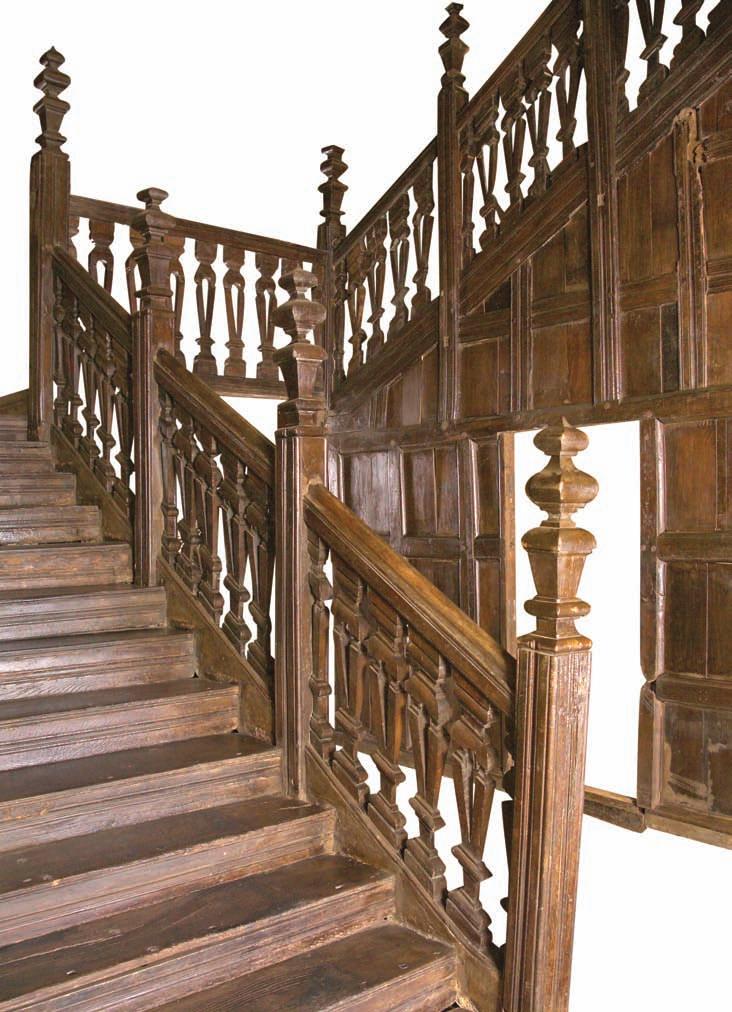
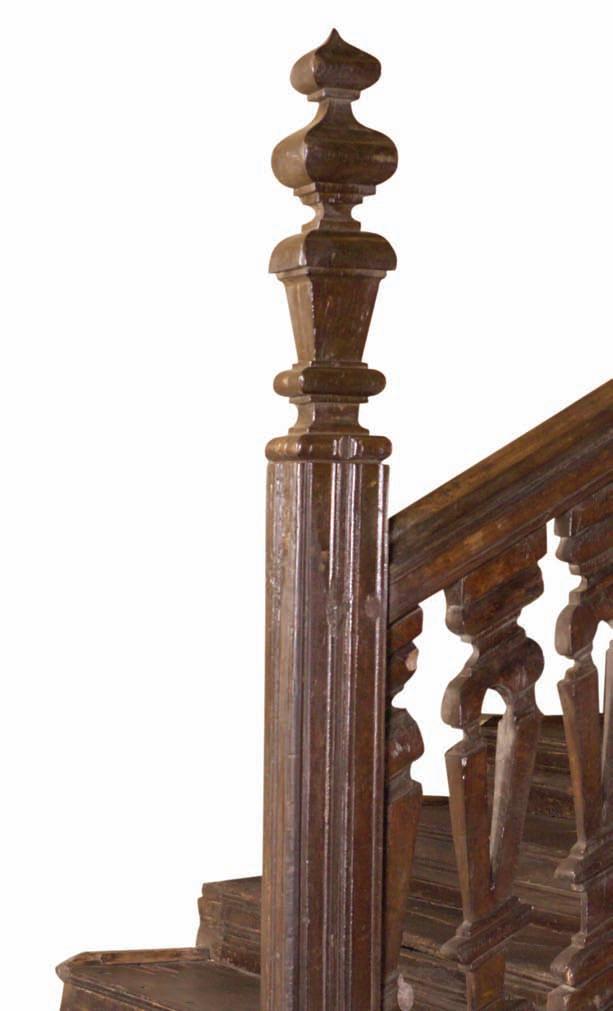
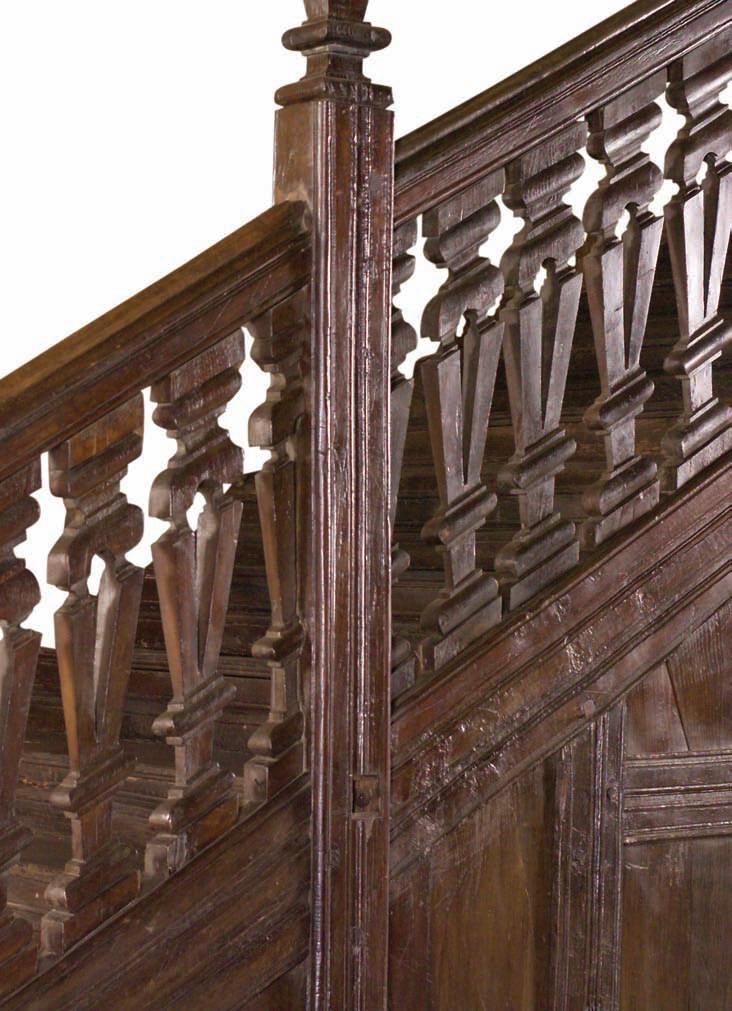
The Lavenham Ceiling
An English 15th century oak ceiling, circa 19 0
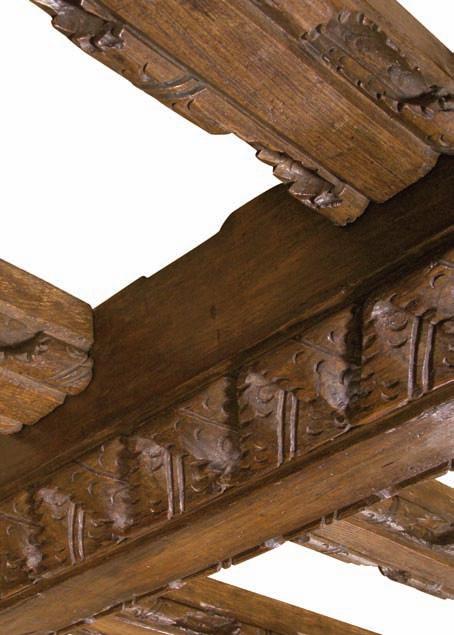
Purchased by William Randolph Hearst, circa 1926. Known to the trustees of the Hearst estate as The Lavenham Hall Ceiling, this rare ceiling may have come from one of the houses linked to the de Vere family who owned Lavenham Hall.
Length of main spine 11 ´ 9½˝ [359 cm] Length of joists 7 ´ 7 ˝ [235 cm]
Ceiling space 11 ´ 9½˝ [359 cm] x 16´ 1½˝ [95 5 cm]
Extra pieces 5 lengths each of ´ 2½˝ [128 cm]
1 length of 7 ´ 10½˝ [20 cm] 1 length of 6´ 8½˝ [225 cm]
Provenance: the estate of William Randolph Hearst.
[ 20 ]
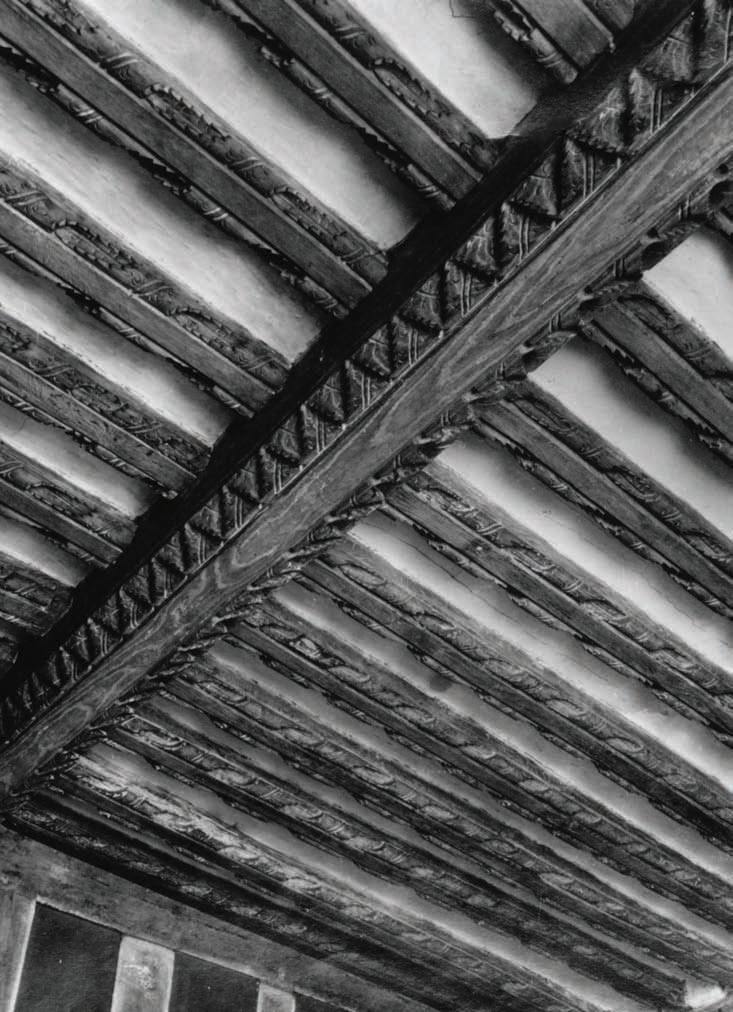
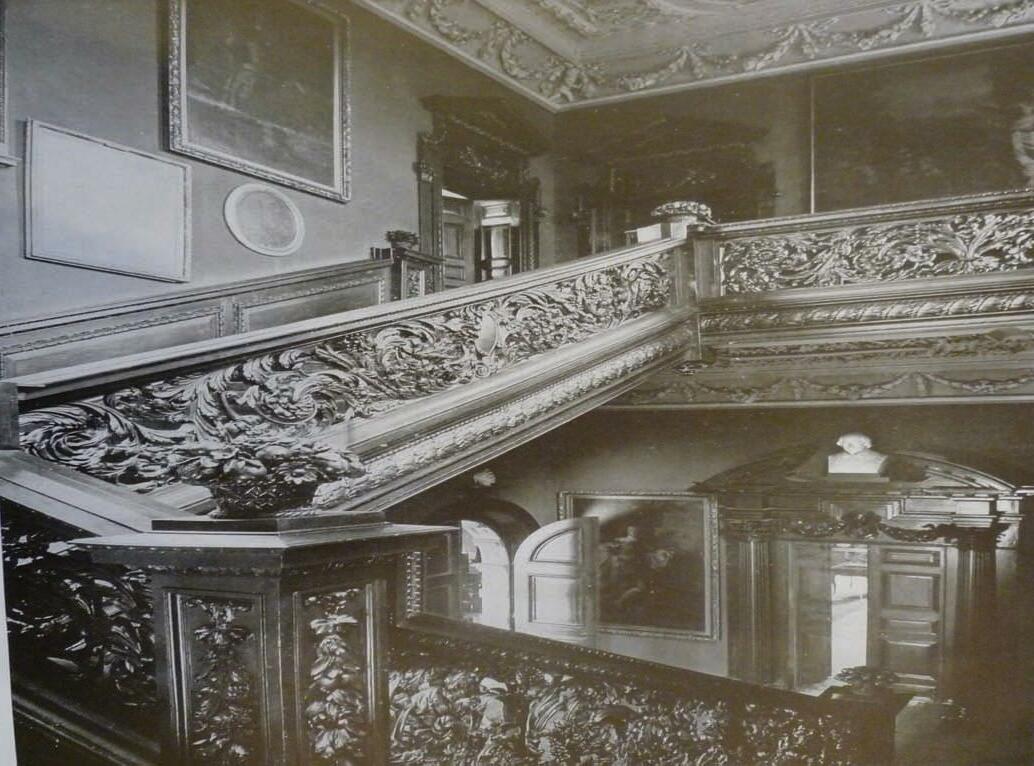
The Crakemarsh Hall Stair
A mid to late 17th century carved oak staircase with accompanying pine panelling; this stair was rescued prior to Crakemarsh Hall’s demolition. Nikolaus Pevsner in the 1950s described Crakemarsh Hall as a ‘compact two story stucco villa circa 1820, …all very quiet and modest; and a surprise to find that the house seems to have been built (or possibly re-built) around a sumptuous 17th century staircase’. The staircase, which occupied the whole of the entrance hall, has lavish open panels of acanthus foliage set between large square newels decorated with fruit. The stair, now without runners and risers, consists of three extravagantly carved oak rising rails and a single return gallery carved in the manner of Edward Pearce (circa 1630–1698). Though the sales particulars for the Hall and estate in 1968 list the stair as ‘almost certainly the work of Grinling Gibbons’ Pevsner suggests that the Crakemarsh Stair is a copy of the ‘Great Stair at Sudbury Hall by Edward Pearce’, illustrated opposite.
Pierced balustrades were first used in the early 17th century, when designs were generally geometric. Elaborate carving seems to have introduced around the 1630s, an example of which can be seen at Ham House, embellished with military trophies and cannon, with the newel posts supporting baskets of fruit and flowers. Similar finials, although usually with urns rather than baskets, became popular for the grandest staircases in the period from around 1650 to 1690. The Crakemarsh Hall Stair had such finials, now sadly lost, with the newel posts having carved panels incorporating a drop of fruit and foliage suspended from a bow. The carving in the balustrades takes the form of scrolls of acanthus foliage around central flowers, possibly sunflowers; snakes and a peacock are in evidence with more acanthus leaf carving to the handrail string. It is worth noting that the main stair at Tredegar House has recently been dated by dendrochronology, giving felling dates from 1666
1672, and though there are subtle differences, the Tredegar stair is remarkably similar to that of Crakemarsh Hall.
At Sudbury Hall the handrails have an unusual angular ramping, a feature also seen in the Crakemarsh Hall Stair, which is of note because of the proximity of Crakemarsh to Sudbury. So where did this stair come from? Panelled rooms, staircases and architectural features from this period are known to have been removed and refitted in other properties, with one possible candidate for this early architectural salvage being Ruperra Castle, which is the sister house to Tredegar. Ruperra had its original stair taken out and a new one inserted in the late 18th century, which fits in chronologically with the dates for Crakemarsh Hall’s construction.
The Crakemarsh Hall Stair is a rare survivor from a short list of existing staircases from the mid to late 17th century which have carved and pierced balustrades. It is the only and possibly the last ever stair of this type and age to come to market recently, the last being sold to the Metropolitan Museum, New York.
I wish to thank Linda Hall and Mark Baker for their expertise when compiling this description.
[ 23 ]
–
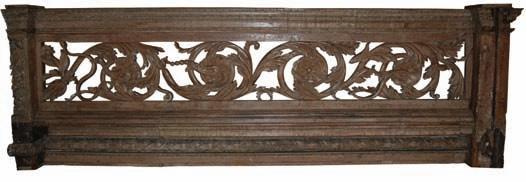
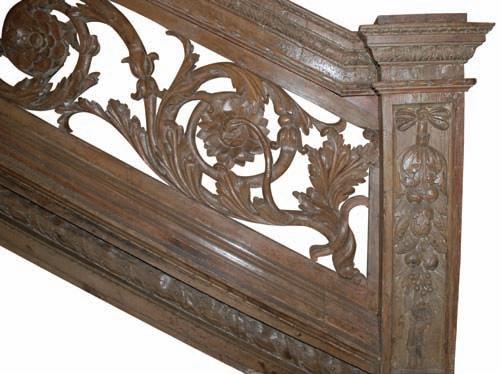
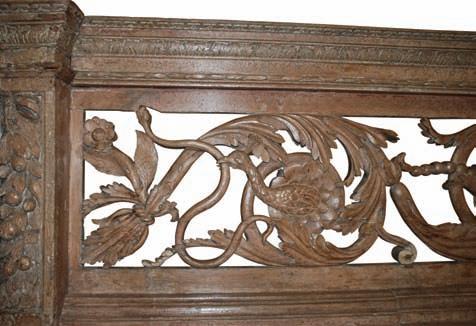
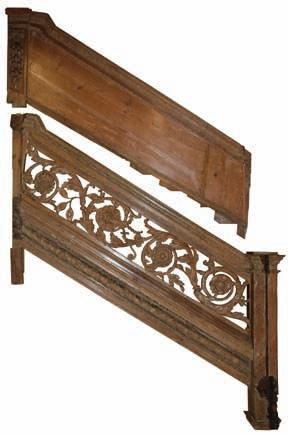
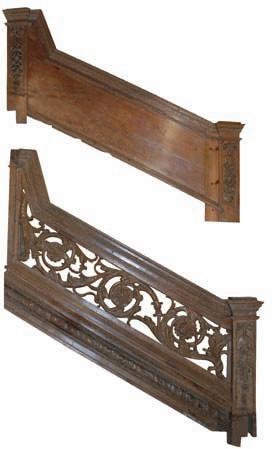
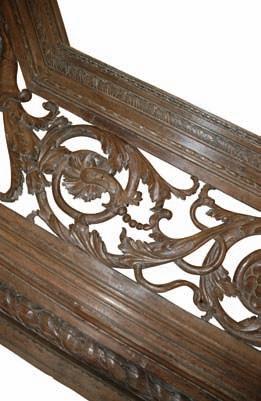
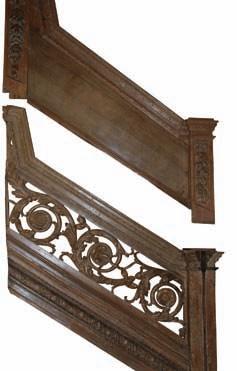


A George III, circa 1800, pine and composite fire surround; the central tablet having phoenix, reed and thistle decoration flanked by swags of grape and vine, and the jambs having unusual tripartite cluster columns. Additional embellishments include boars’ heads, egg and dart, and acorn motifs. Provenance: removed in the early 1980s from a property on Forth Street, Edinburgh, Scotland. Style and date would relate to buildings designed on this street by Robert Burn.
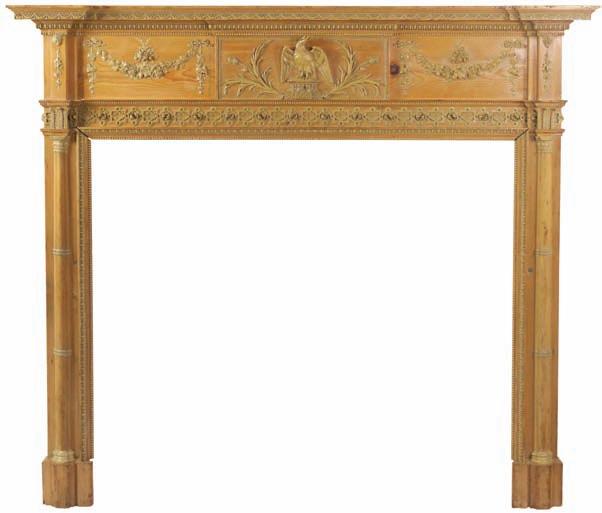
[ 26 ]
Height 5 ´ ¼˝ [153 cm] Shelf width 5 ´ 9¼˝ [176 cm] Internal height 3 ´ 8¼˝ [112 cm] Internal width ´ 2¾˝ [129 cm]
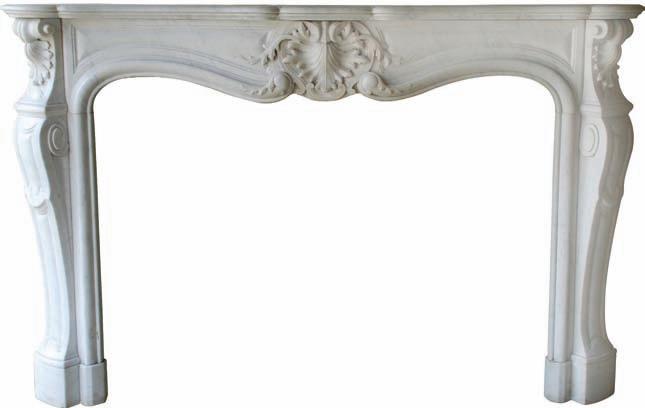
[ 27 ]
Height 3 ´ 6˝
5 ´ 5 ˝
A carved Carrara marble chimneypiece in Louis XV style, circa 1880, having scrolled jambs with shell and central frieze, foliate central panel and serpentine shelf.
[107 cm] Overall width
[165 cm]
An impressive early 19th century fireplace in natural limestone; the arched aperture having ornately carved central corbel flanked by elaborate spandrels, the jambs in the form of flat pilasters recessed and carved with roses and foliage capitols, the shelf having dental frieze, acanthus carved central dias and canted top. Circa 1860
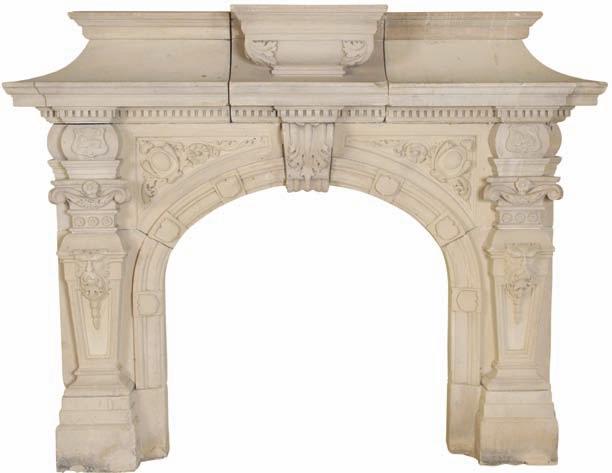
Height 6´ 3½˝ [192 cm] Width 7 ´ 10 ˝ [239 cm]
Internal height 3 ´ 7 ˝ [11.5 cm] Internal width ´ [122 cm]
Provenance: The Mansion House, Ludlow, Shropshire.
[ 28 ]
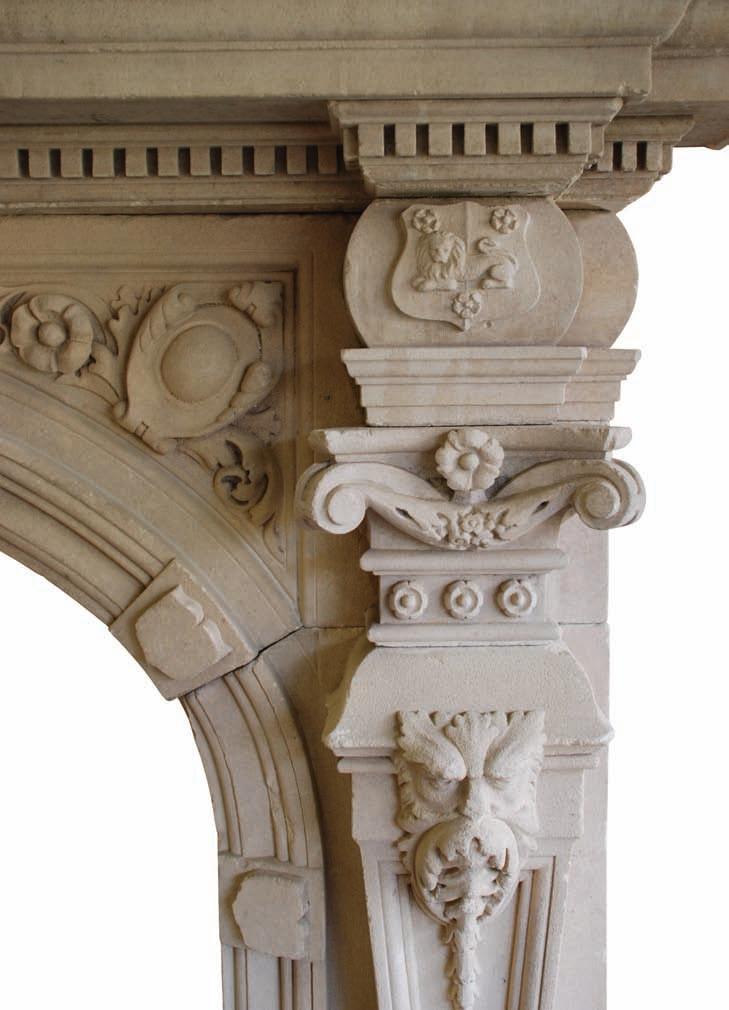
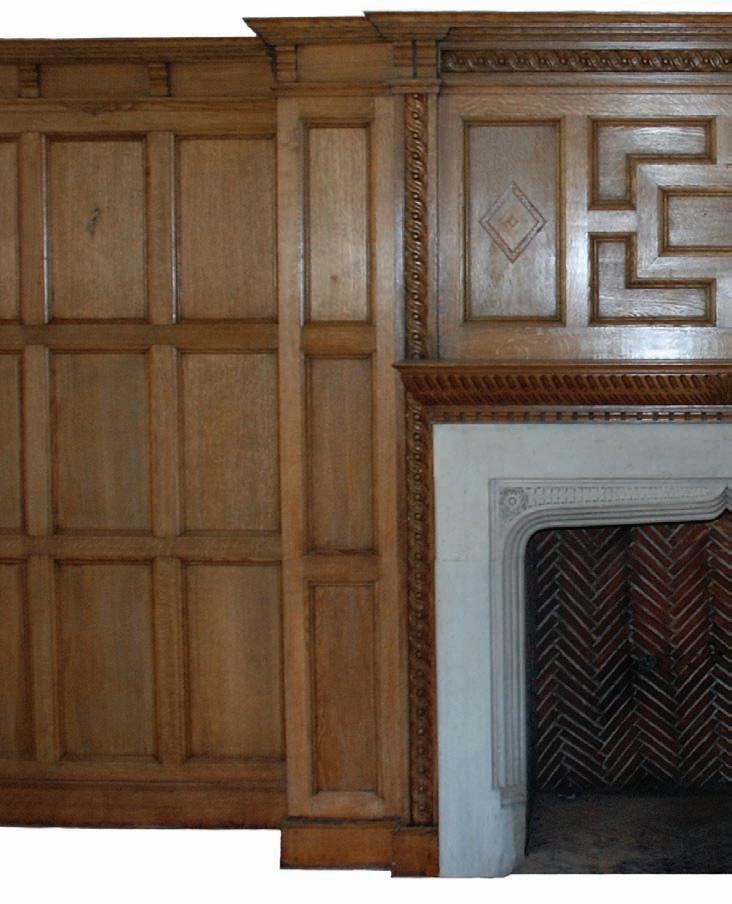 An oak panelled room with stone fireplace, circa 1910, removed from Queen Anne House, Oxshott. Full dimensions on request.
An oak panelled room with stone fireplace, circa 1910, removed from Queen Anne House, Oxshott. Full dimensions on request.
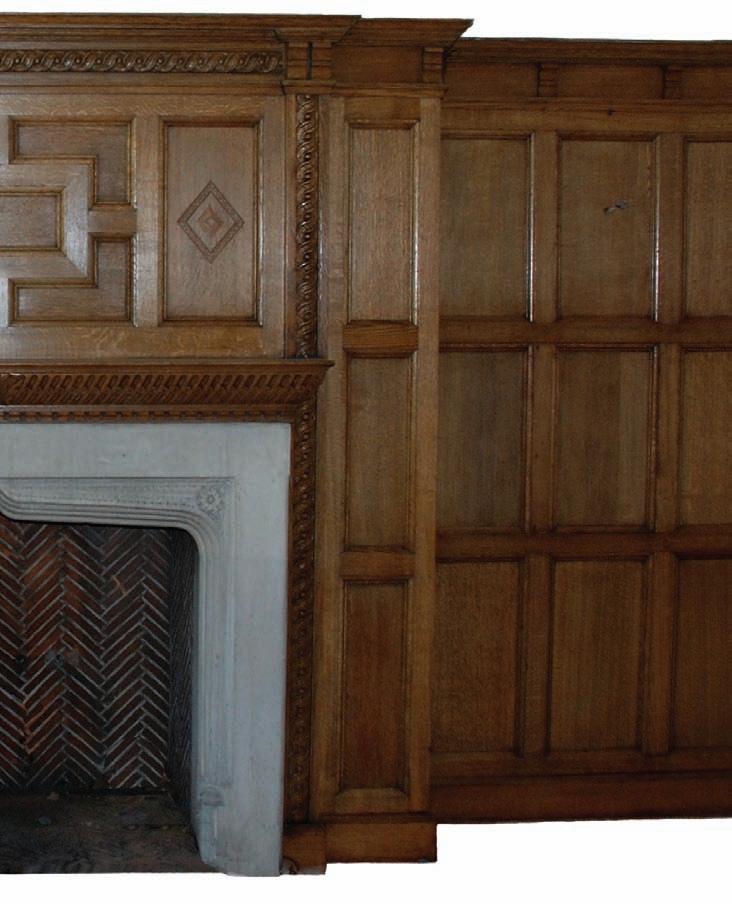
[ 31 ]
A cast iron fireback depicting lions rampant with an armorial crest and fleurs de lis, circa 150. A similar example was held in the Wayte Collection.
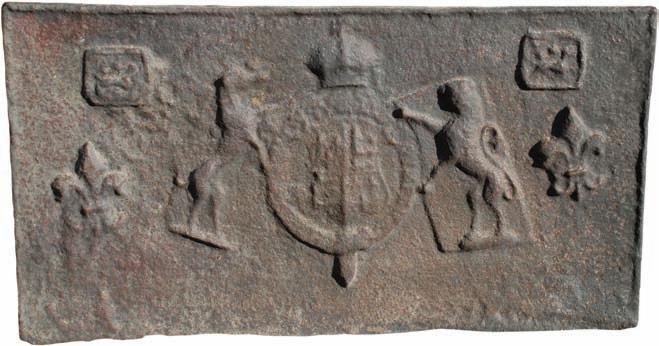
[ 32 ]
1 ´ 11 ˝ [58 5
Width 3 ´ 6¾˝ [108 5 cm]
Height
cm]
An early 20th century iron grate with decorative fire dogs.
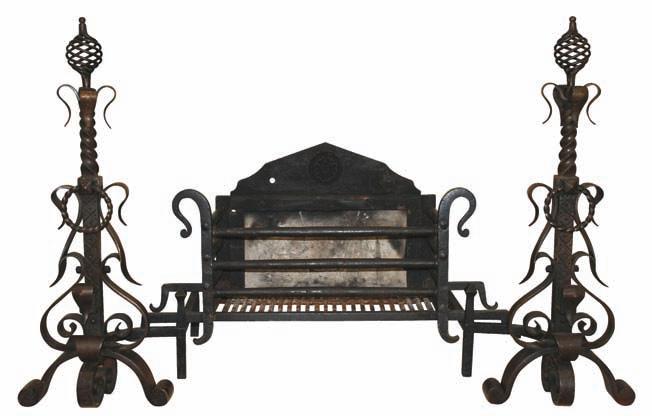
Height of fire dogs 2 ´ 10 ˝ [86 cm] Overall width ´ 2 ˝ [137 cm]
Depth 2 ´ [61 cm]
Provenance: Bolney Court, Oxfordshire, England.
[ 33 ]
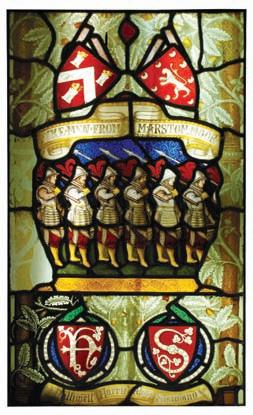
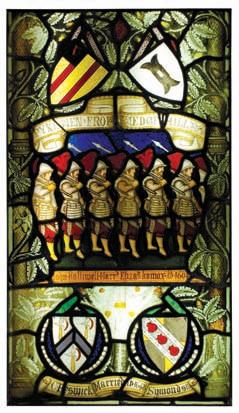
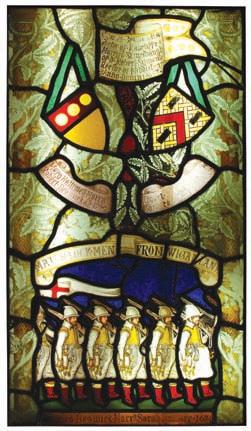
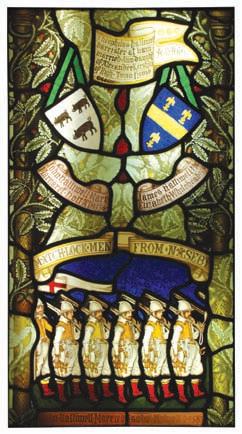
[ 3 ]
The Pyke House Glass
Dating from the early 17th century, Pyke, latterly Pike House, situated near Littleborough, Lancashire, was the ancestral home of the Halliwell family, thence the Beswick Royds. Pyke House was demolished in 1960, however the painted glass windows were saved and were kept safe, stored, still wrapped in newspaper of that date, for over fifty years. Two panels depict the Pikemen who were known to have been stationed at the house during the Civil War, where ten men guarded the road under Richard Halliwell in support of King Charles. The other windows extravagantly show the family tree of the Halliwell and Royds families against a backdrop of events relating to Civil War battles, alongside coats of arms, all set against patterned foliage. The windows are known to have been set in ‘a window on the staircase landing.’ The two further armorial windows were also known to have been set on either side of the front door.
A pair of stained glass windows depicting pykemen from Marston Moor and Edgehill
A pair of stained glass windows depicting matchlock men from Wigan and at Naseby
A pair of stained glass windows depicting Sir Edwards Stanley’s archers from Latham and Richard Beswick’s Lancashire archers at Flodden Field
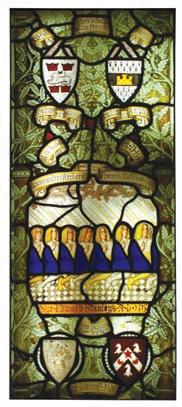
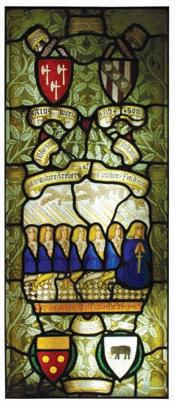
[ 35 ]
Height 2 ´ 11 ˝ [89 cm] Width 1 ´ 7½˝ [9.5 cm]
Height 2 ´ 11½˝ [90 cm] Width 1 ´ 7½˝ [9.5 cm]
Height 3 ´ 8¾˝ [11 cm] Width 1 ´ 7½˝ [9.5 cm]
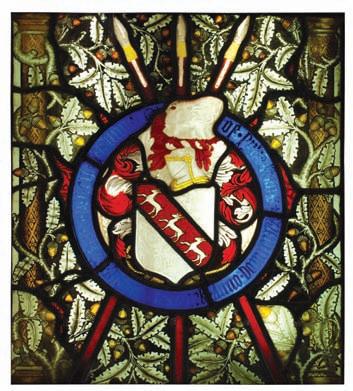
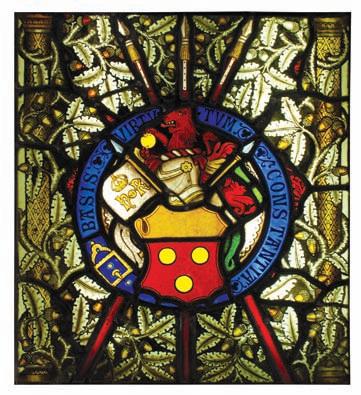
[ 36 ]
A pair of armorial glass windows from Pyke House Height 1 ´ 10¼˝ [56.5 cm] Width 1 ´ 7½˝ [9.5 cm]
Two pairs of early 19th century scagliola columns, circa 1820. The columns, which have a shaft imitating Sienna marble, are raised upon a black marble base with a finely cast plaster socle with ionic capitol.



Height 7' 5½˝ [220.75 cm] Square at base 1' 1½˝ [3 25 cm] Provenance: Crakemarsh Hall.

[ 37 ]
A French, neo-Gothic, wrought iron and parcel gilt wall light attributed to Frédérick Schertzer (185 – 1929), with scrolling support and pierced trefoil motifs to the sockets, circa 1880
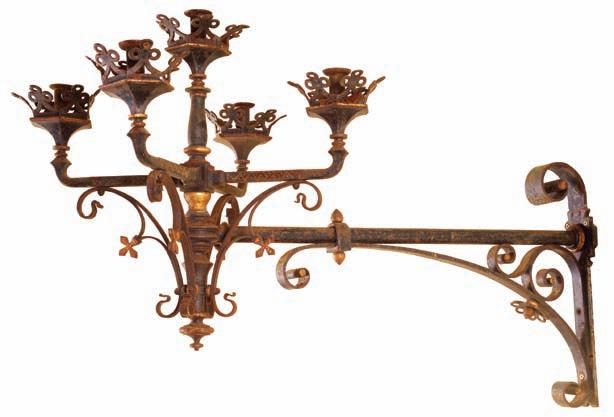
Five available.
Height 1 ´ 7¾˝ [50 cm] Extension 3 ´ [92 cm] Provenance: a chateau near Lorraine.
[ 38 ]
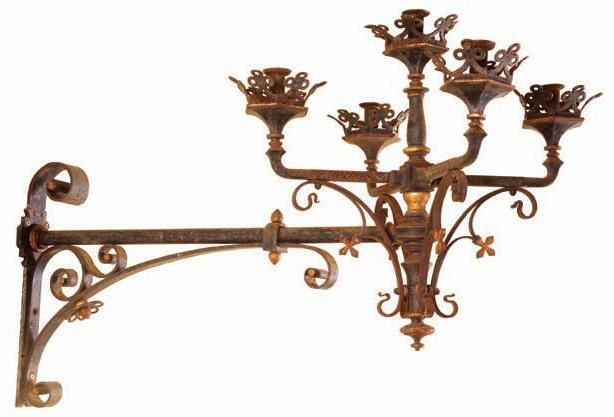
[ 39 ]
An early 18th century lead figure of a dancing girl with cymbals from the workshops of John van Nost the Elder (1686–1711–1713), previously thought to be 1729. The disputed death date of John van Nost is an example of the grey areas that surround early lead ornament. The question of authentication of early English lead work is fraught with difficulty. This model of a dancing putto could relate to van Nost’s Master, one Arnold Quellin (1653–1686), whose wife, on his passing, van Nost married. Indeed this work, notwithstanding the possible Low Countries connection to the Larson family, could have been modelled and cast by Andrew Carpenter (1677–1737), he being principal assistant at van Nost’s workshops in London’s Haymarket.
It is then confusingly also possible that this work could be a later casting from an early mould by ‘the man at Hyde Park Corner’ John Cheere (1709
1787), who took over van Nost’s business and moulds upon van Nost’s death. All this said, it is most likely that the stylistic similarities to the fighting putti at Melbourne House and the general manner of the piece points firmly towards John van Nost the Elder. The figure shows a naked, save the ‘classic’ later applied fig leaf, putti dancing with cymbals, on tip-toe, with the body in movement and her head to one side. The figure sports a hairstyle not dissimilar to other known models by van Nost.
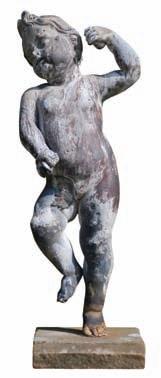
Condition – the surface of the lead shows some oxidisation of iron and the body has taken a number of ‘pot shots’ from air rifle marksmen! A small seepage of iron deposits is in evidence on one of the ankles which relates to corrosion of the iron armature embedded within the core; however this is currently in a stable condition.
Height 2 ´ 8˝ [82 cm] Square at base 10¼˝ [26 cm] Provenance:
[ 0 ]
–
Peelings Manor, East Sussex.
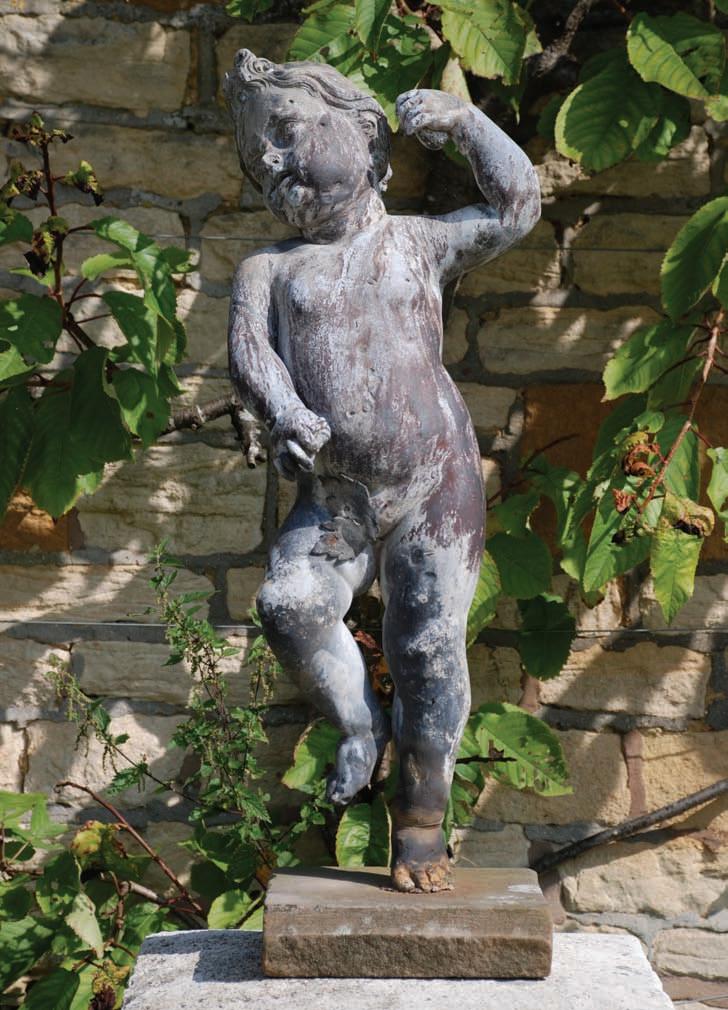
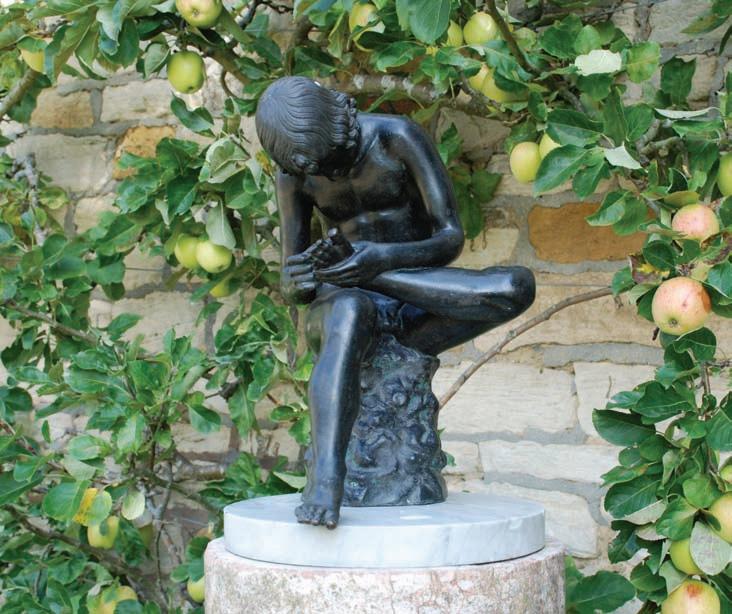
[ 2 ]
Height 1 ´ 2¾˝ [37 cm] Width 9¾˝ [25 cm] Depth 12 ˝ [30.5 cm]
A Neapolitan bronze model of the Spinario raised on a circular marble plinth, circa 1900
A
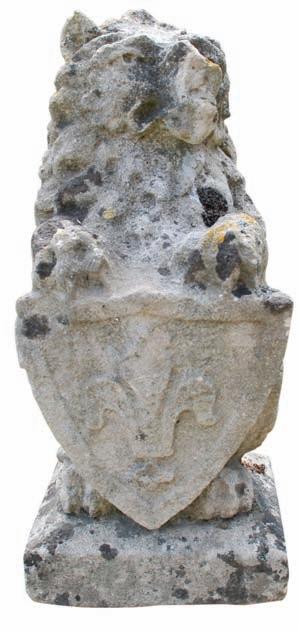
Height 1 ´ 11 ˝ [53 5 cm] Width 10 ˝ [55 5 cm] Depth 1 ´ [30 5 cm]
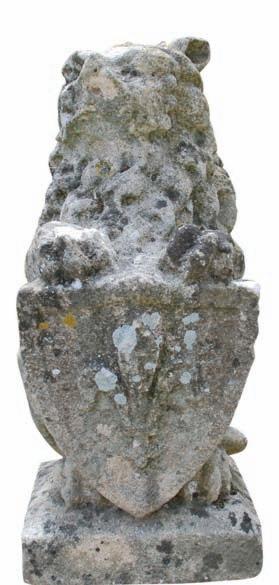
[ 3 ]
pair of Bath stone lions holding shields with fleur de lys, circa 1920
A French 19th century terracotta figure of Bacchante, a female devotee of the cult Bacchus, typically depicted with swirling drapery, playing music and with the expression of physical abandon. Raised upon a circular marble pedestal.
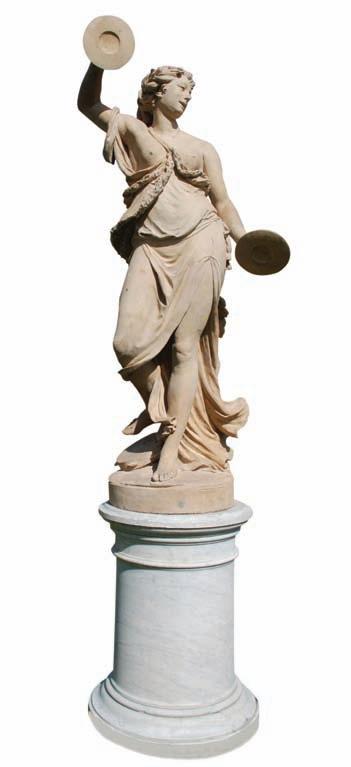
Height 6´ 3 ˝ [190 5 cm] Diameter at base 1 ´ 8˝ [51 cm]
Height of pedestal 3 ´ [91.5 cm] Diameter of pedestal 2´ [61 cm]
[ ]
A 19th century Italian marble fountain in the form of a stylised dolphin, circa 1820.
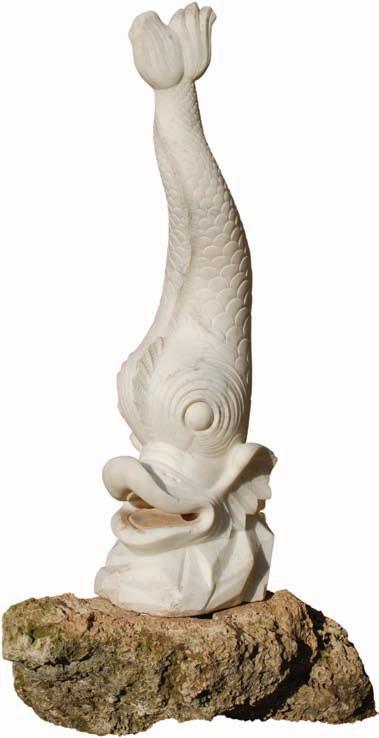
Height 3 ´ 1¾˝ [96 cm] Width 9¾˝ [25 cm]
Depth 1 ´ 1¾˝ [35 cm]
[
]
5
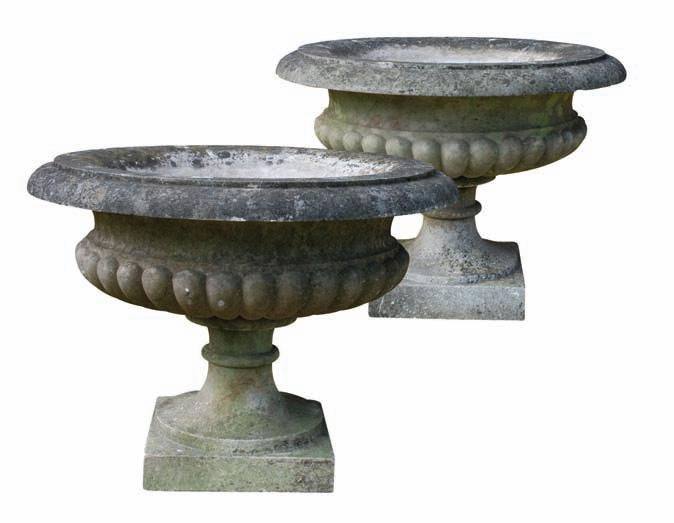
[ 6 ]
1 ´ 8½˝
52
Diameter 2 ´ ˝ [
A pair of late 19th century marble tazza urns, circa 1890
Height
[
cm]
71 cm]
A large scale 19th century composition campana shaped urn having acanthus leaf decoration on a fluted socle – indistinctly stamped sbol [ ] , raised on a weathered modern carved stone pedestal (optional).
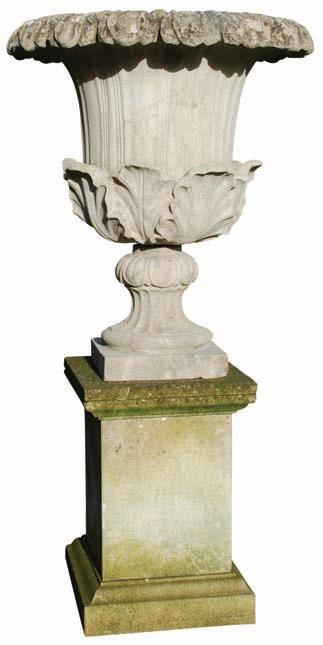
Height 3 ´ 1 ˝ [9 cm] Diameter 2 ´ 9 ˝ [8 cm]
Overall height on optional pedestal 5 ´ 2 ˝ [158 cm]
[ 7 ]
A pair of early 20th century lead urns, having simple scroll handles embellished with acanthus leaves to the base and cherubs to the main body, raised on a circular socle.
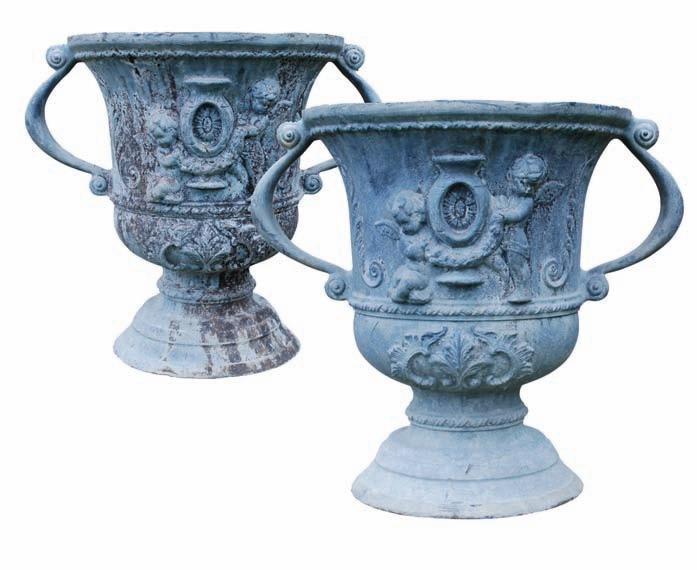
Height 1 ´ 5½˝ [ cm] Diameter 1 ´ 3 ˝ [38 cm]
Overall width including handles 1 ´ 8˝ [51 cm]
[ 8 ]
A pair of Compton Pottery planters of circular form with scroll handles, circa 1910. This model relates to the Wottan design as sold by Liberty & Co.
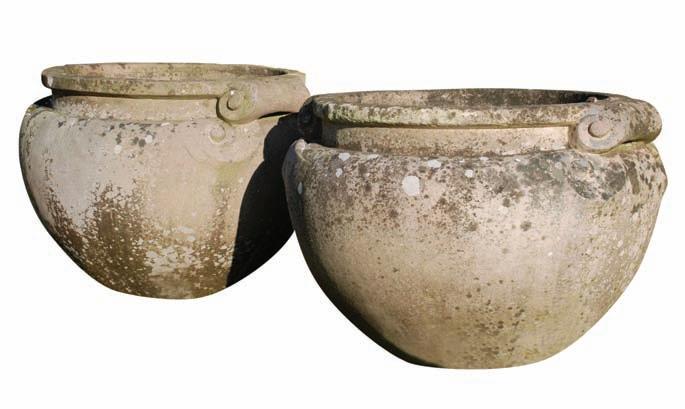
[ 9 ]
Height 1 ´ 3 ˝ [38 cm] Diameter 1 ´ 8½˝ [52 cm]
A large 19th century cast iron planter, previously a water tank, thought to be from a narrow guage railway.
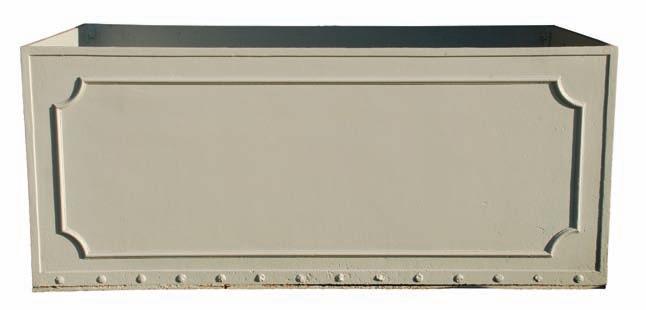
[ 50 ]
Height 2 ´ 6½˝ [77.5 cm] Width 5 ´ 11½˝ [182 cm] Depth 2 ´ 1¼˝ [95 cm]
A pair of early 19th century French stone half fruit baskets.



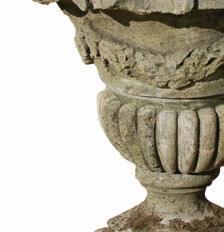

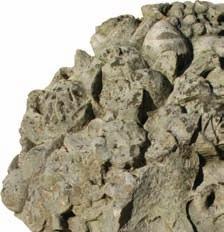
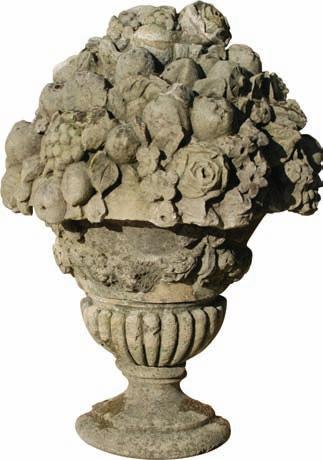
[ 51 ]
Height 3 ´ 8˝
112
Overall width 2 ´ 5 ˝ [7
Depth 1 ´ 3 ˝ [
[
cm]
cm]
38 cm]
A pair of early 20th century Cotswold stone urns, circa 1910.
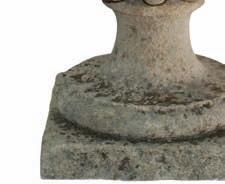
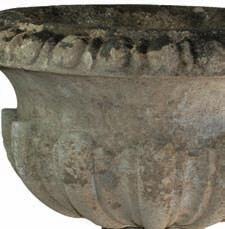
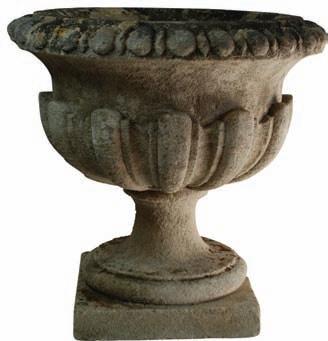
Height 1 ´ 5 ˝ [3 cm] Diameter 1 ´ 5 ˝ [3 cm]



Square at base 9½˝ [2 cm]
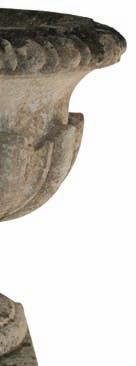
[ 52 ]
A single 20th century Cotswold stone urn, circa 1900.
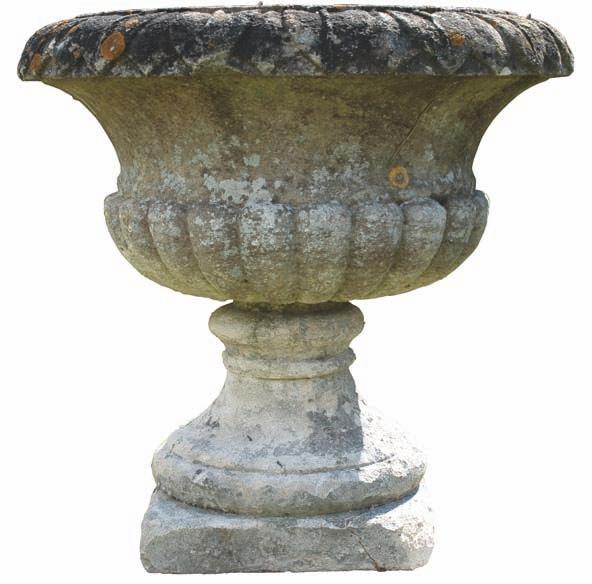
Height 1´ 11½˝ [60 cm]
Diameter 2´ [61 cm]
Square at base 10¾˝ [27 cm]
[ 53 ]
A pair of late 19th century Spanish decorative wrought iron balustrade ends converted into gates, having intricate leaf, flower and foliage work and raised jardinière holders to each end. Circa 1890.
Height 3 ´ 8½˝ [113 cm] Overall Width 5 ´ 3½˝ [156 cm]
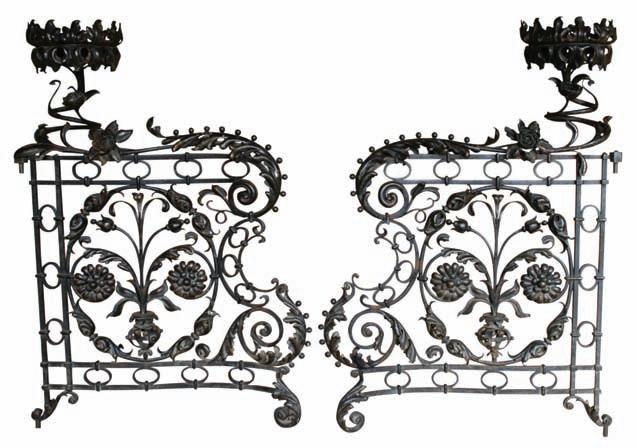
[ 5 ]
A pair of wrought iron gates having scroll work and climbing rose decoration. Circa 1950 Height ´ 7½˝ [11 cm] Width 6´ 2½˝ [189 cm]
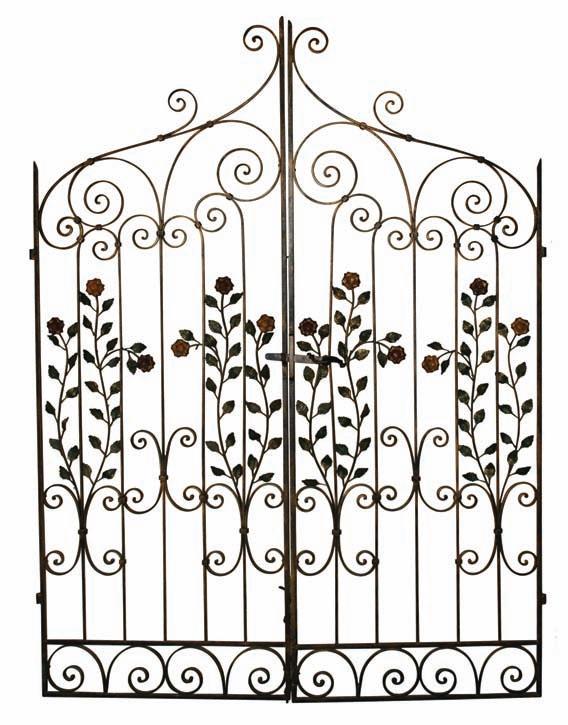
[ 55 ]
An early 19th century wrought iron garden gate. Height 5
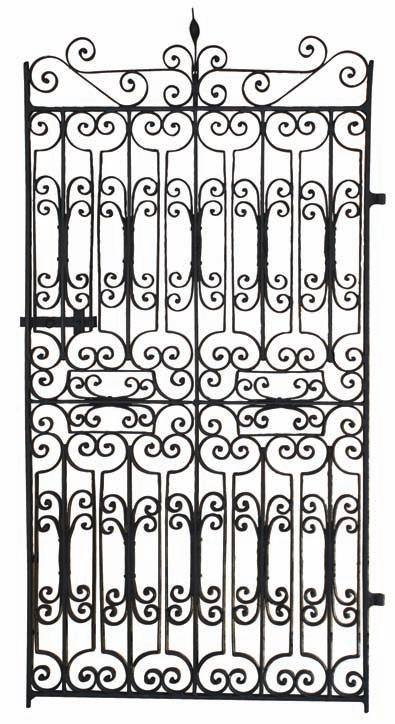
[168 cm] Width
[81 cm]
[ 56 ]
´
˝
´
6
2
8˝
A late 18th century wrought iron single garden gate.
[107 cm]
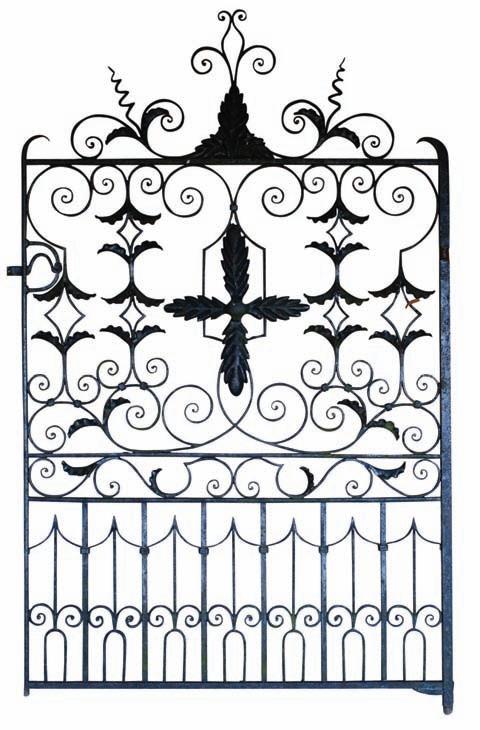
[ 57 ]
Height 5 ´ 9 ˝
3 ´ 6˝
[175 cm] Width
The Flamingo Gate
Designed and made by Antony Robinson, circa 1983
Forged from mild steel, galvanised and painted white.
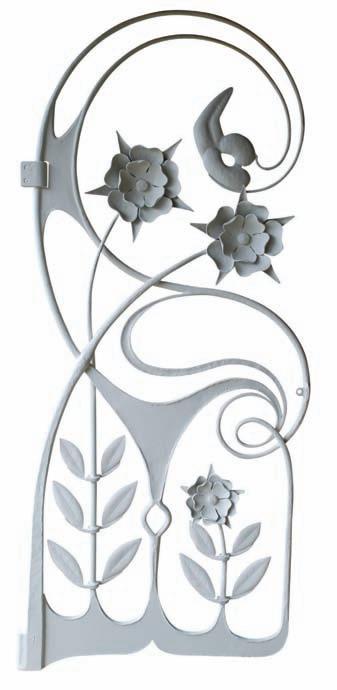
Height 6´ 6˝ [198 cm] Width 2 ´ 9 ˝ [8 cm]
Provenance: Castell Gyrn, Ruthin, Wales.
[ 58 ]
The Lodge House Gates
Designed and made by Antony Robinson, circa 1983.
Forged in mild steel, galvanised and painted black.
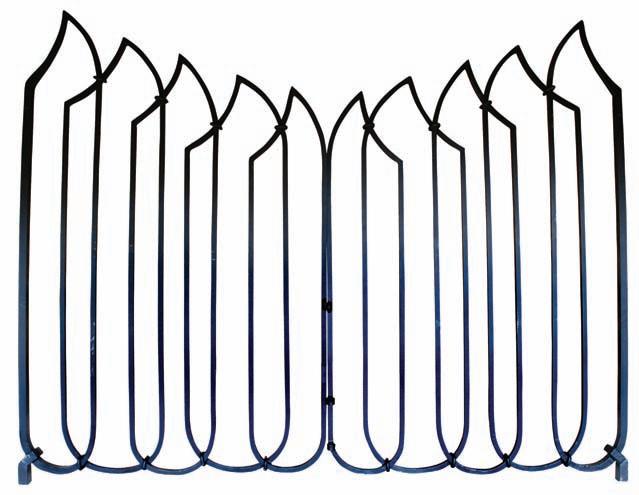
Height 7 ´ 10 ˝ [239 cm] Width 10 ´ [305 cm]
Provenance: Castell Gyrn, Ruthin, Wales.
[ 59 ]
A pair of mid 20th century wrought iron gates.
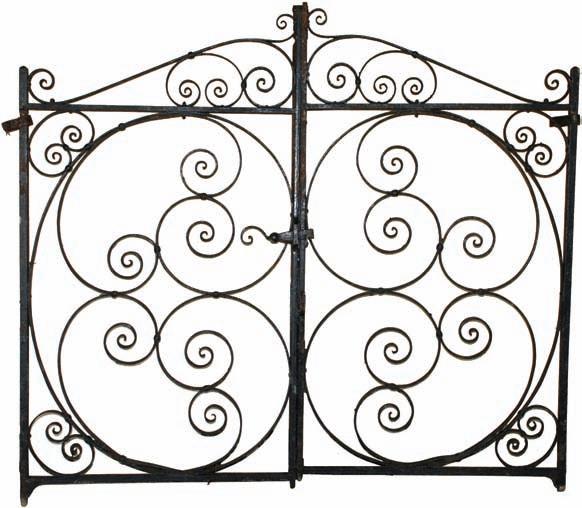
[ 60 ]
Height ´ 3 ˝ [130 cm] Width ´ 7½˝ [11 cm]
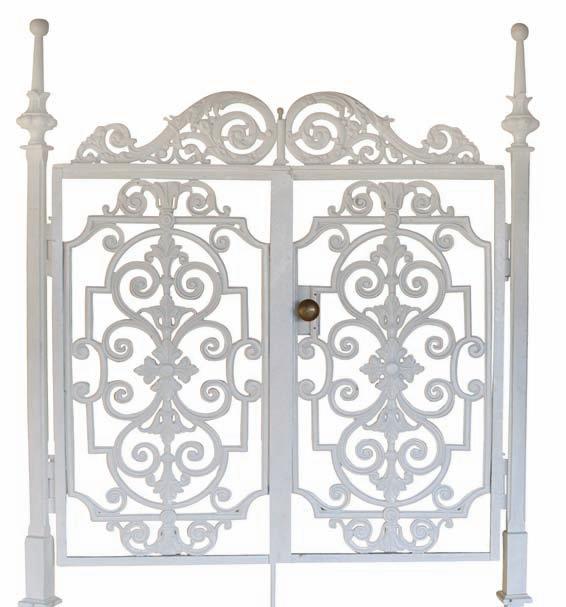
[ 61 ]
5 ´
3 ´ ½˝
A pair of Victorian cast iron garden gates, circa 1870, having cast inset panels surmounted by decorative scrollwork and hinged on finialled gate piers.
Height
7½˝ [172 cm] Width
[103 cm]
, 52,25
James Simons worked out of 17 Marylebone Street from 1791–1793, with the inscription of Redgrave 52,25 suggesting that base and dial were once on the Redgrave Hall Estate, Redgrave, Suffolk. Note: conservation to socle.
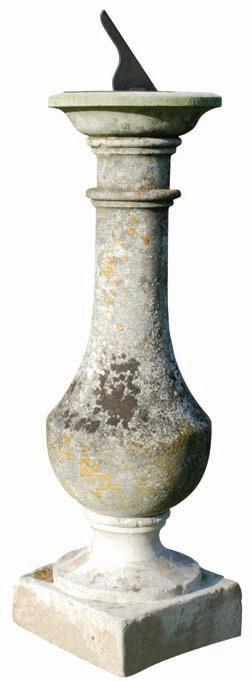
[ 62 ]
An 18th century Portland stone pedestal of baluster form surmounted by original bronze dial plate by James Simons. Dial plate inscribed: J. simons mary le bone street,
Height of stonework ´ 1 ˝ [125 cm] Cap diameter 1 ´ 2½˝ [37 cm] Square at base 1 ´ 2½˝ [37 cm]
An 18th century Portland stone octagonal sundial having lobed and pearl decoration to the baluster base, sweeping up to a collar with an egg and dart moulding under the plain moulded cap.

Circa 1760. The bronze dial plate is a replacement.
Height of stonework 3 ´ 10 ˝ [117 cm] Overall width 1 ´ 5 ˝ [3 cm]
Provenance: Saling Hall, Great Saling, Essex.
[ 63 ]
An early 20th century Hornton stone sundial of octagonal baluster form. Circa 1900.
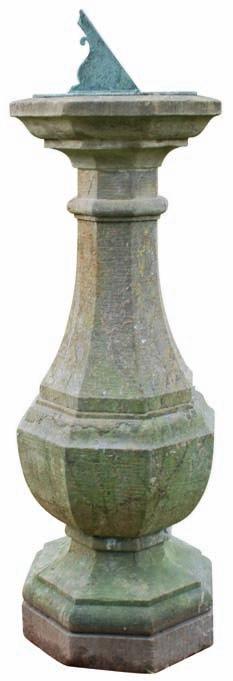
[ 6 ]
Height
3 ´ 3 ˝ [107
Overall width 1 ´ 3 ˝ [38 cm]
of stonework
cm]
A late 19th century Italian carved limestone garden seat, circa 1880, with double arched back flanked to either side by lobed urns on carved block plinths, with three lobed and waisted leg supports.
Height ´ 8˝ [12 cm] Width 10 ´ 6˝ [320 cm] Depth 1 ´ 11 ˝ [58.5 cm]
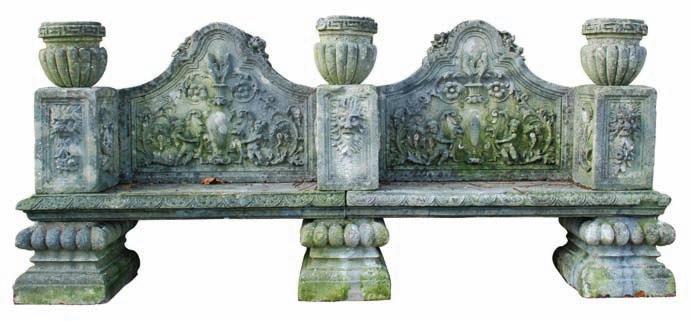
[ 65 ]
An early 20th century steel-sprung three seater sofa seat. This design of seat was developed in the third quarter of the 19th century in response to the demand for seating required for Parisian open parks, boulevards and outdoor concerts. Its simple bent steel rod and spring construction, patented by François A Carre in 1866, was produced not only in Paris by the Val d’Osne foundries but also Schlesinger Wiessener & Co of Vienna and New York and Lalance & Grosjean again in New York, this company later purchasing the patent from Carre to produce these seats.
It is interesting to note that this design carried on being popular until 1930, proving resilient to the elements and equally at home in a public space or private garden.
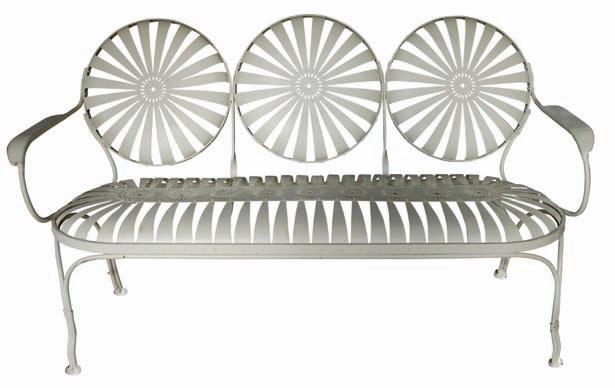
[ 66 ]
Height 2 ´ 10 ˝ [86.5 cm] Width ´ 9 ˝ [150 cm] Depth 2 ´ 2 ˝ [66 cm]
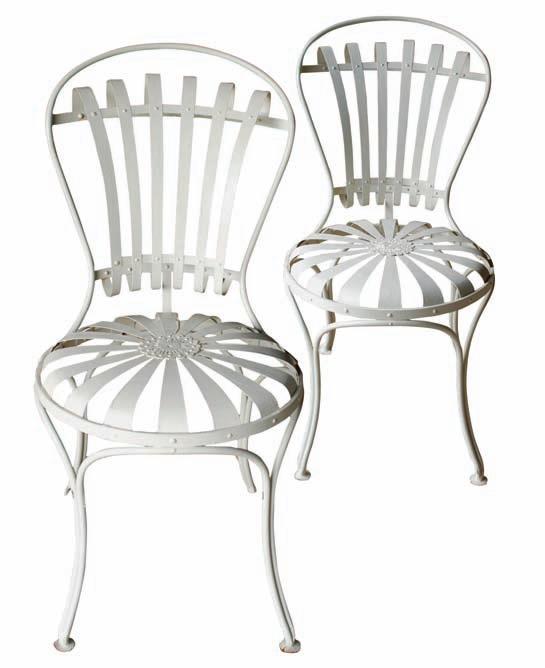
[ 67 ]
Height 2 ´ 8˝ [81 cm] Width 1 ´ ˝ [1 cm] Depth 1 ´ 10 ˝ [56 cm]
A pair of early 20th century steel-sprung boulevard chairs after the design of François A Carre, circa 1900.
An early 20th century Arts & Crafts style oak bench. Height 3 ´ 1½˝ [95 cm] Width 6´ [18 cm] Depth 2 ´ [61 cm]

[ 68 ]
An early 20th century Arts & Crafts style oak bench. Height 3 ´ 1½˝ [95 cm] Width 6´ [18 cm] Depth 2 ´ [61 cm]
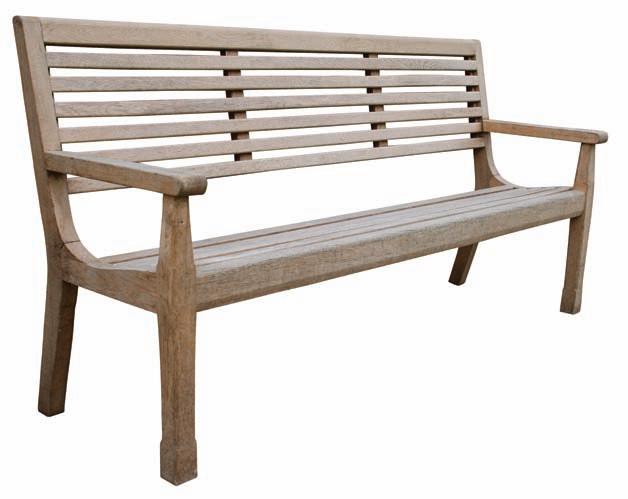
[ 69 ]
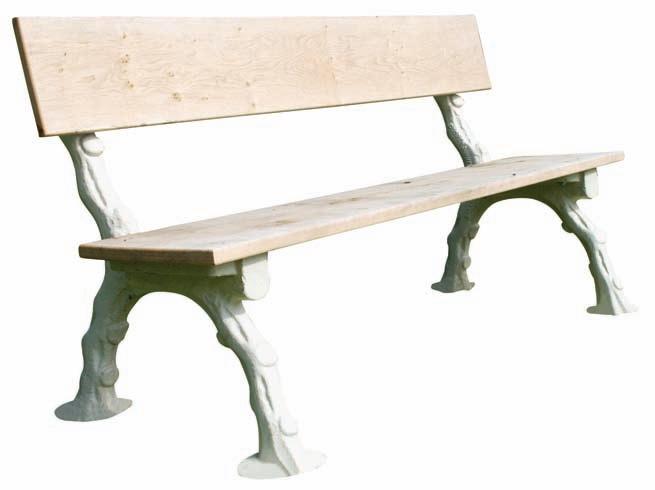
[ 70 ]
Height 2 ´ 5 ˝ [7 cm] Width 5 ´ [152 5 cm] Depth 2 ´ [61 cm]
A late 19th century cast iron garden seat formed as stylised branches, stamped ‘Cooper and Whittaker Angoates’, re-slatted in English oak.
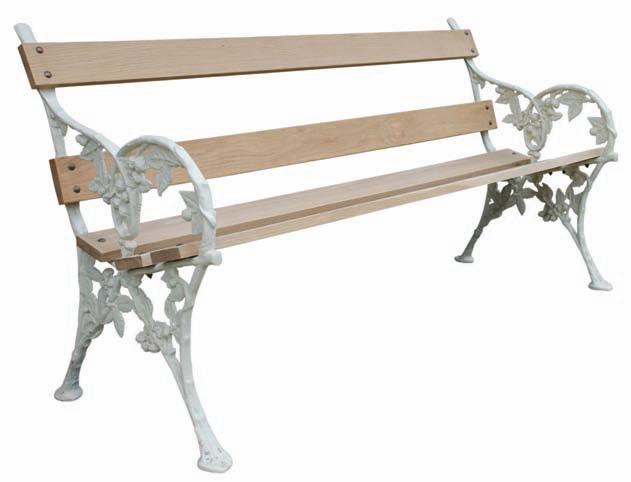
[ 71 ]
2 ´ 7½˝ [80
Width 5 ´ [153
Depth 1 ´ 10 ˝ [56
A cast iron bench with fruit and vine decoration, re-slatted in English oak, circa 1930
Height
cm]
cm]
cm]
A pair of early 20th century bent iron chairs with spiral seat and back panels.
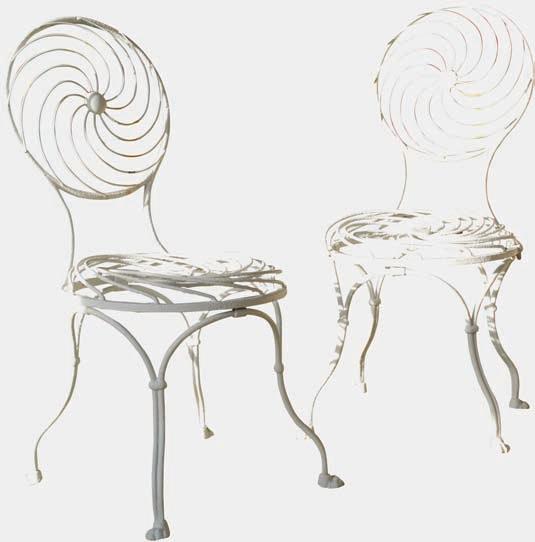
[ 72 ]
Height 2 ´ 11 ˝ [89 cm] Width 1 ´ ¼˝ [1 cm] Depth 1´ 6˝ [6 cm]
A set of four mid century decorative iron garden chairs having lattice slat, leaf and flower decoration.
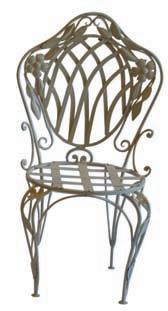
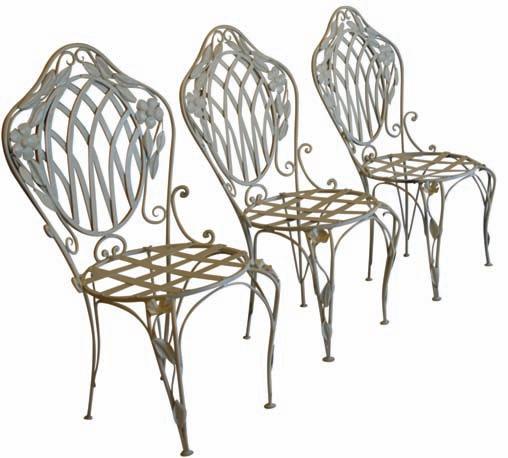
Height 3 ´ 3¼˝ [100 cm] Width 1 ´ 6˝ [6 cm]
Depth 1´ 5½˝ [ 5 cm]
[ 73 ]
A late 19th century Italian carved Carrara marble bench, the bench top having shallow carved decoration to the edge, raised upon supports in the form of acanthus scroll and stylised paws. Circa 1890.
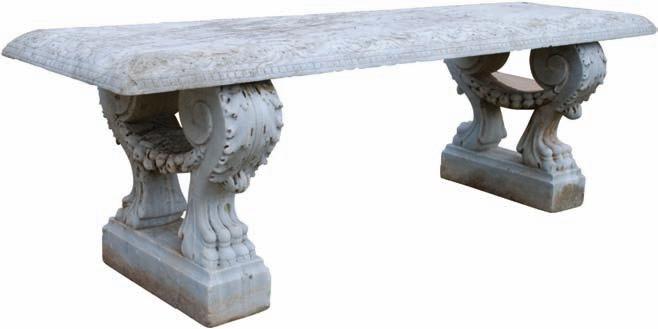
Height 1´ 5˝ [3 cm] Width ´ 11˝ [150 cm]
Depth 1´ ¾˝ [2.5 cm]
[ 7 ]
A late 19th century Italian carved Carrara marble bench, the bench top having shallow carved decoration to the edge, raised upon supports in the form of acanthus scroll and stylised paws. Circa 1890.
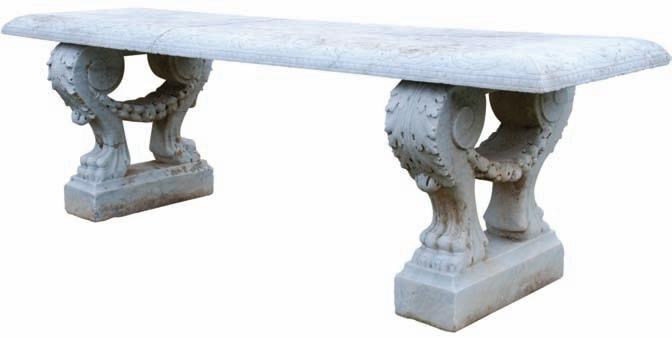
Please note restoration to bench top and support.
Height 1´ 5˝ [3 cm] Width ´ 11˝ [150 cm]
Depth 1´ ¾˝ [2.5 cm]
[ 75 ]
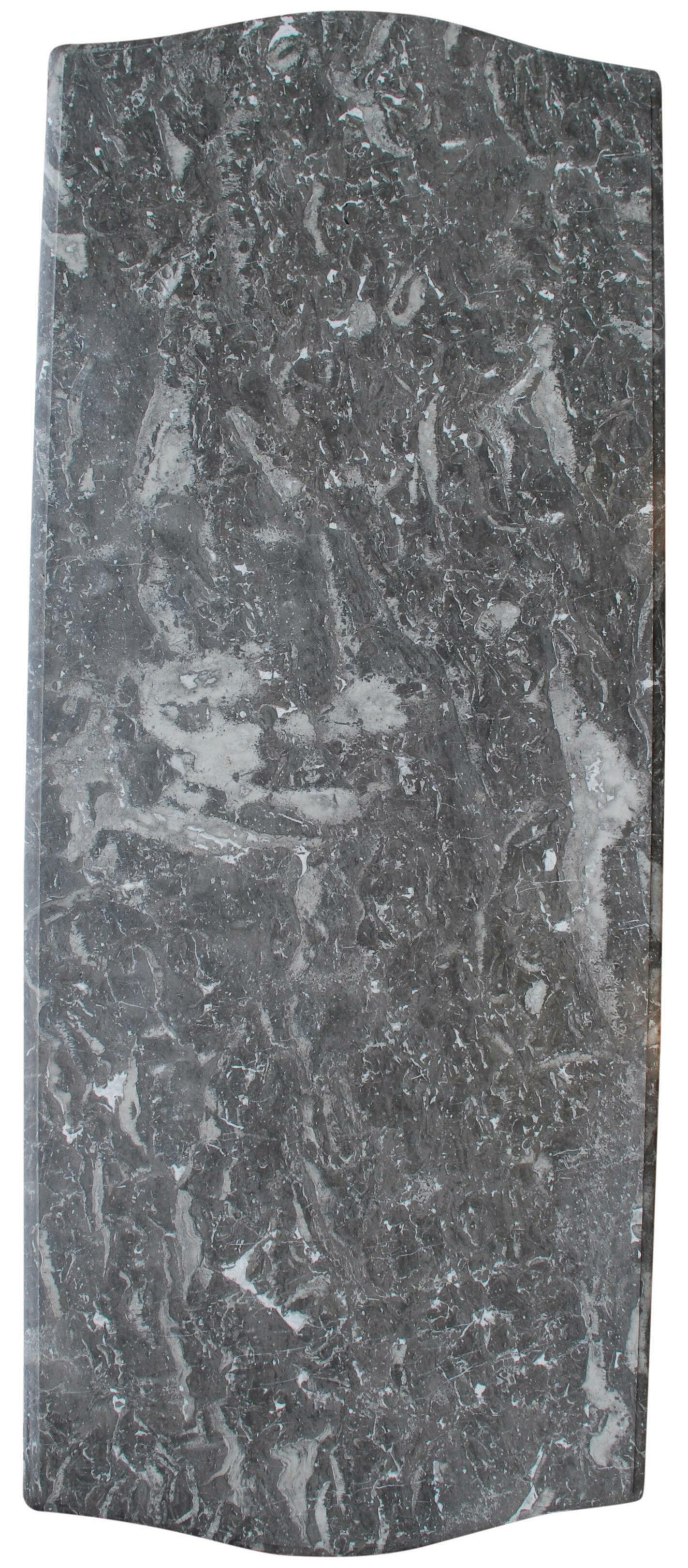
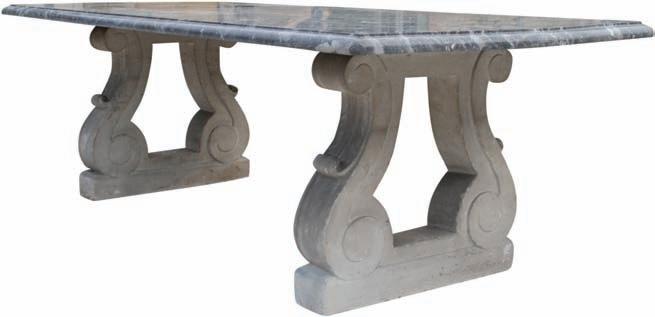
[ 77 ]
Height 2 ´ 5 ˝ [7 cm] Length 8´ 2 ˝ [29 cm] Depth 3 ´ 3 ˝ [
An early 20th century French Orobian Arabesque marble table supported on carved limestone voluted scroll supports.
99 cm]
A mid 20th century circular wrought iron occasional table with later slate top.
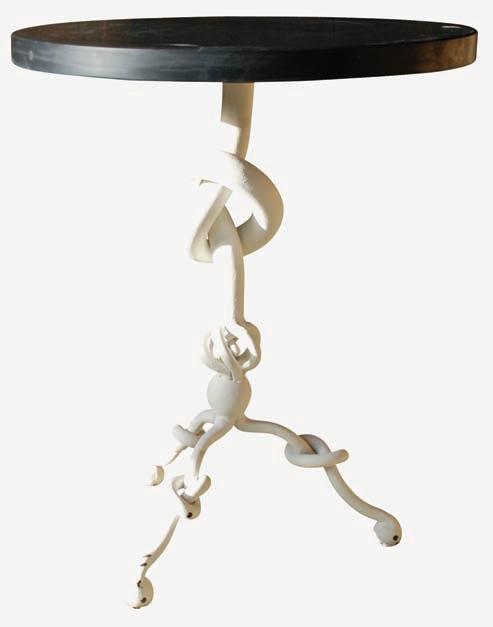
[ 78 ]
Height 2 ´ 9½˝
85 cm] Diameter 2 ´ 3½˝
[
[70 cm]
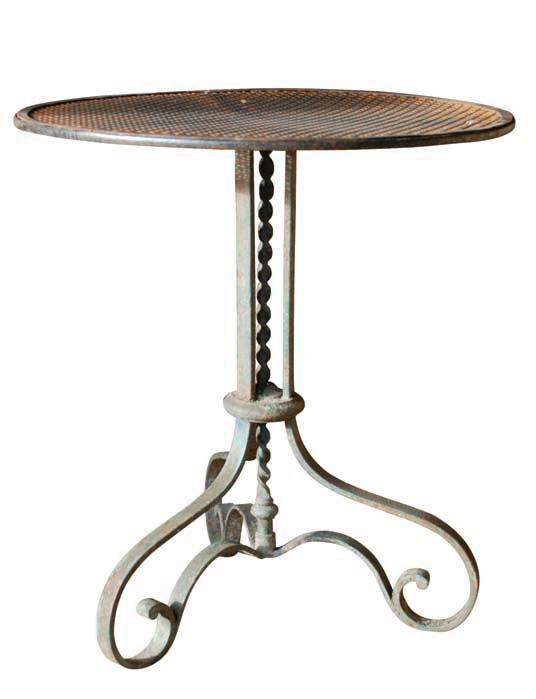
[ 79 ]
2 ´ ¾˝
2 ´ 1¾˝
A French wrought iron circular garden table, circa 1910 Height
[
73 cm] Diameter
[65.5 cm]
An 18th century trough; troughs always in stock.
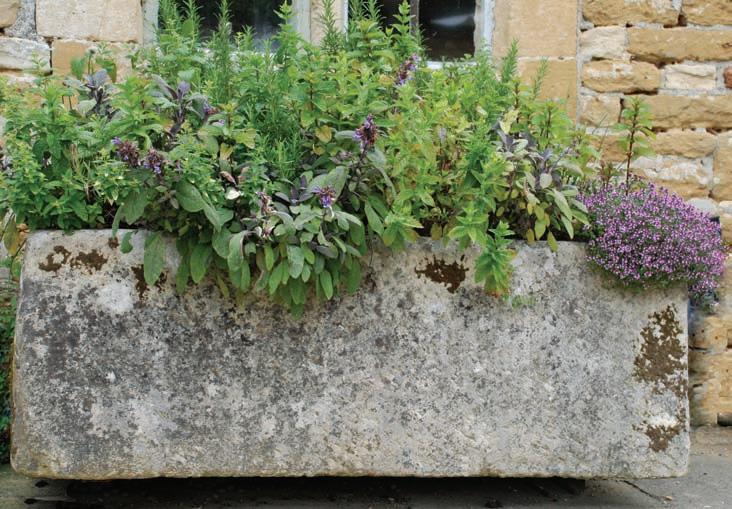
[ 80 ]
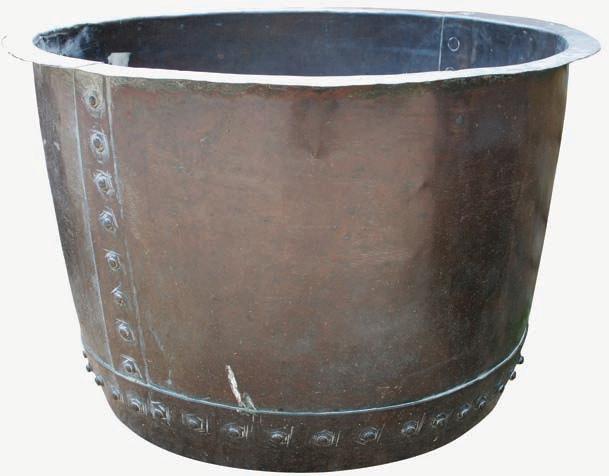
[ 81 ]
A copper copper; Victorian coppers always in stock.
Period Garden Statuary
Architectural Heritage always seeks to source the finest examples of 18th, 19th and early 20th century garden statuary, ornament and water features available, with a strong emphasis on aesthetic value, provenance and historical interest.
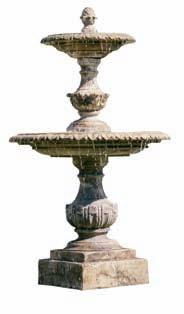
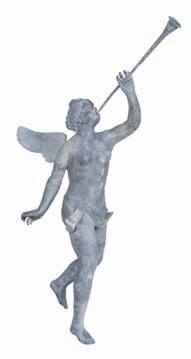
Architectural Heritage
Period Garden Statuary, Architectural Elements & Modern Sculpture
Price List 2012
Modern Sculpture
Street Sweeper by Peter Laszlo Peri
Joy of Life by Thomas Bayliss Huxley-Jones
Preening Bird by David Wynne
Untitled by Jon Isherwood
Untitled by Richard Perry Bedford
Holding it Together by Peter Randall-Page
Lucien Crofts by Barry Flanagan
Ivan Maisky by Jacob Epstein
Warrior by Elisabeth Frink
Peter by Reca McGibbon
Untitled by Willi Soukop
Artist’s Resale Right (ARR)
Architectural Elements
The Llwyn Ynn Staircase
The Lavenham Ceiling
The Crakemarsh Hall Stair
A George III pine and composite fire surround, circa 1800
A carved Carrara marble chimneypiece in Louis XV style, circa 1880
A large early 19th century carved stone fireplace
An oak panelled room with stone fireplace, circa 1910
A cast iron fireback depicting lions rampant, circa 1540
An early 20th century iron grate with decorative fire dogs
The Pyke House Glass - a pair of panels with Pikemen
The Pyke House Glass - a pair of panels with Matchlock Men
The Pyke House Glass - a pair of panels with Archers
The Pyke House Glass - a pair of armorial panels
A pair of early 19th century scagliola columns
A pair of early 19th century scagliola columns
A French neo-Gothic wrought iron and parcel gilt wall light
A French neo-Gothic wrought iron and parcel gilt wall light
Statuary & Fountains
An early 18th century lead figure of a dancing girl
An early 20th century Neapolitan bronze model of The Spinario
A pair of early 20th century Bath stone lions
A mid 19th century French terracotta figure of Bacchante
A late 19th century Italian marble dolphin fountain
Urns, Planters & Finials
A pair of late 19th century marble tazza urns
A 19th century composition campana shaped urn with stone pedestal
Price
4 5 6 7 8 9 10 11 12 14 15 16 20 23 26 27 28 30 32 33 34 34 35 36 37 37 38 39 40 42 43 44 45 46 47 £ £ £ £ £ £ £ £ £ £ £ £ £ £ £ £ £ £ £ £ £ £ £ £ £ £ £ £ £ £ £ £ £ £ £ Page No. 4,600.00 5,400.00 9,400.00 8,600.00 1,800.00 11,600.00 11,600.00 9,400.00 22,000.00 760.00 1,200.00 86,000.00 24,000.00 64,000.00 5,600.00 5,600.00 28,000.00 18,000.00 1,600.00 1,600.00 2,800.00 2,800.00 3,200.00 1,600.00 9,000.00 9,000.00 860.00 860.00 18,000.00 1,800.00 2,400.00 24,000.00 5,600.00 4,600.00 3,400.00
ARR plus ARR plus ARR plus ARR plus ARR plus ARR plus ARR plus ARR plus ARR plus ARR plus ARR
plus
A pair of early 20th century lead urns
A pair of Compton Pottery planters, circa 1910
A large 19th century cast iron planter
A pair of French early 19th century stone half fruit baskets
A pair of early 20th century Cotswold stone urns
A single early 20th century Cotswold stone urn
Gates
A pair of late 19th century Spanish decorative gates
A pair of mid 20th century wrought iron gates with climbing rose
An early 19th century wrought iron single garden gate
A late 18th century wrought iron single garden gate
The Flamingo Gate by Antony Robinson
The Lodge House Gates by Antony Robinson
A pair of mid 20th century wrought iron gates
A pair of Victorian cast iron garden gates
Sundials
An 18th century Portland stone sundial pedestal with dial plate
An 18th century Portland stone octagonal sundial pedestal
An early 20th century Hornton stone sundial pedestal with dial plate
Seats, Benches & Tables
A late 19th century Italian carved limestone garden seat
An early 20th century steel-sprung three seater sofa seat
A pair of early 20th century steel-sprung boulevard chairs
An early 20th century Arts & Crafts style oak bench
An early 20th century Arts & Crafts style oak bench
A late 19th century cast iron garden seat
An early 20th century cast iron seat with fruit and vine decoration
A pair of early 20th century bent iron chairs
A set of four mid 20th century decorative iron garden chairs
A late 19th century Italian carved Carrara marble bench
A late 19th century Italian carved Carrara marble bench
An early 20th century French Orobian Arabesque marble table
A mid 20th century circular wrought iron occasional table
An early 20th century French wrought iron circular garden table
18th century troughs always available Copper
Taddington Manor, Taddington, Nr. Cutsdean, Gloucestershire, England gl54 5ry
Email: puddy@architectural-heritage.co.uk
www.architectural-heritage.co.uk
£ £ £ £ £ £ £ £ £ £ £ £ £ £ £ £ £ £ £ £ £ £ £ £ £ £ £ £ £ £ £ 3,400.00 2,400.00 2,600.00 4,600.00 2,600.00 1,800.00 2,800.00 2,600.00 1,200.00 1,600.00 2,400.00 3,600.00 600.00 1,800.00 7,600.00 8,400.00 3,600.00 12,600.00 1,800.00 860.00 1,200.00 1,200.00 1,200.00 1,200.00 860.00 1,400.00 4,600.00 3,800.00 8,600.00 1,200.00 680.00
Tel: +44 [0] 1386 584 414 Fax: +44 [0] 1386 584 236
48 49 50 51 52 53 54 55 56 57 58 59 60 61 62 63 64 65 66 67 68 69 70 71 72 73 74 75 77 78 79 80 81 Page No. Price
coppers always available
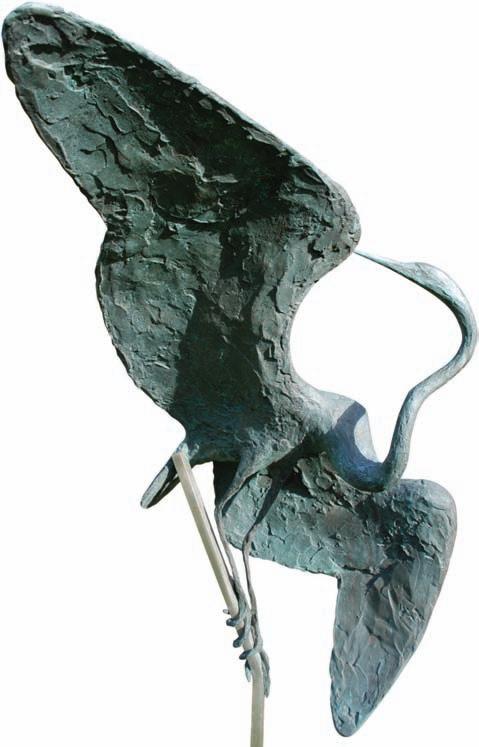
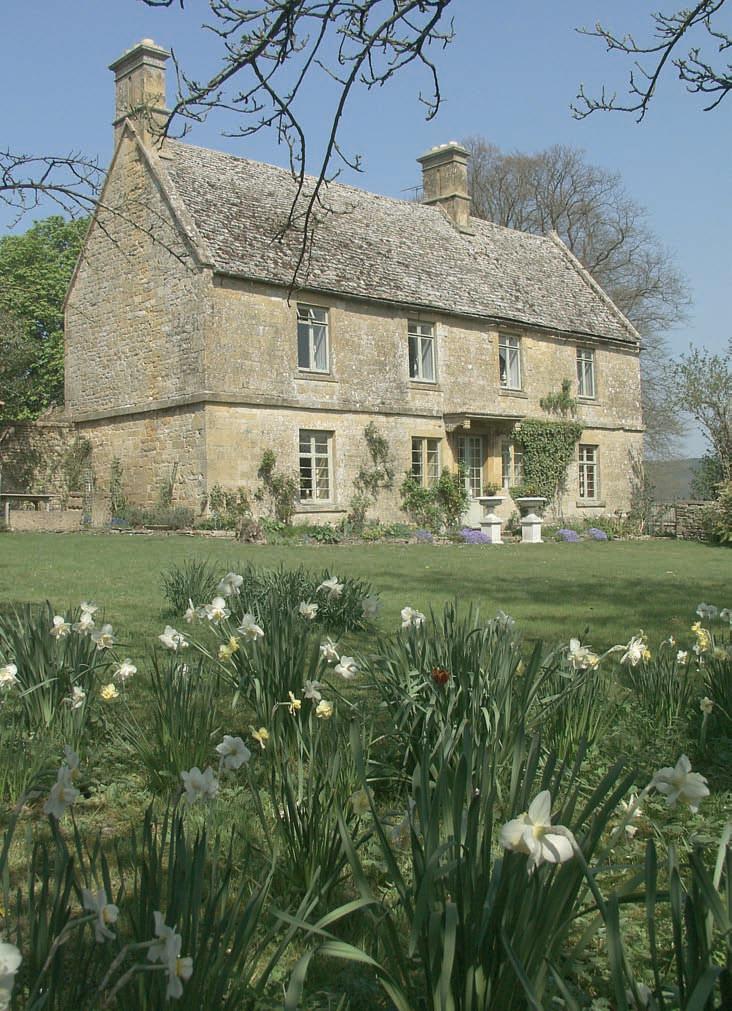
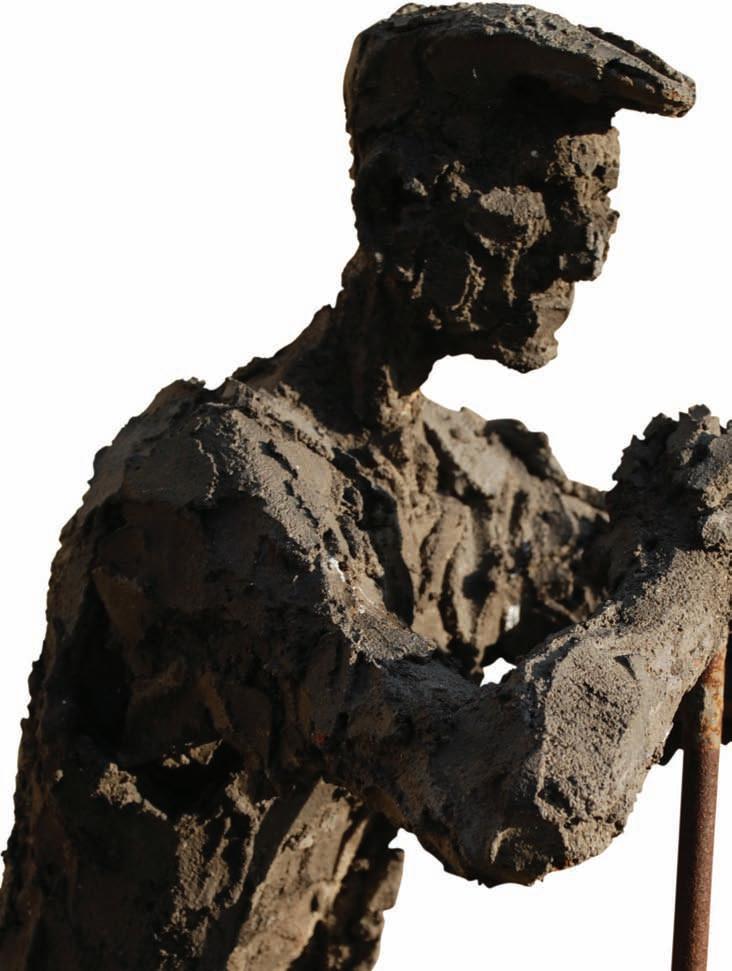










































 An oak panelled room with stone fireplace, circa 1910, removed from Queen Anne House, Oxshott. Full dimensions on request.
An oak panelled room with stone fireplace, circa 1910, removed from Queen Anne House, Oxshott. Full dimensions on request.







































































